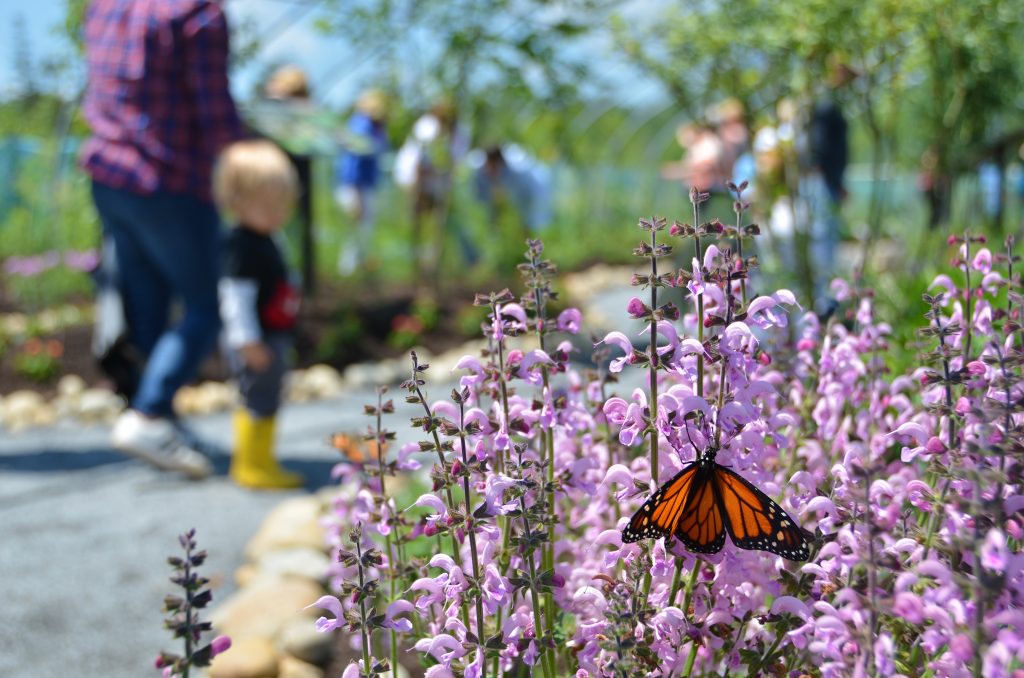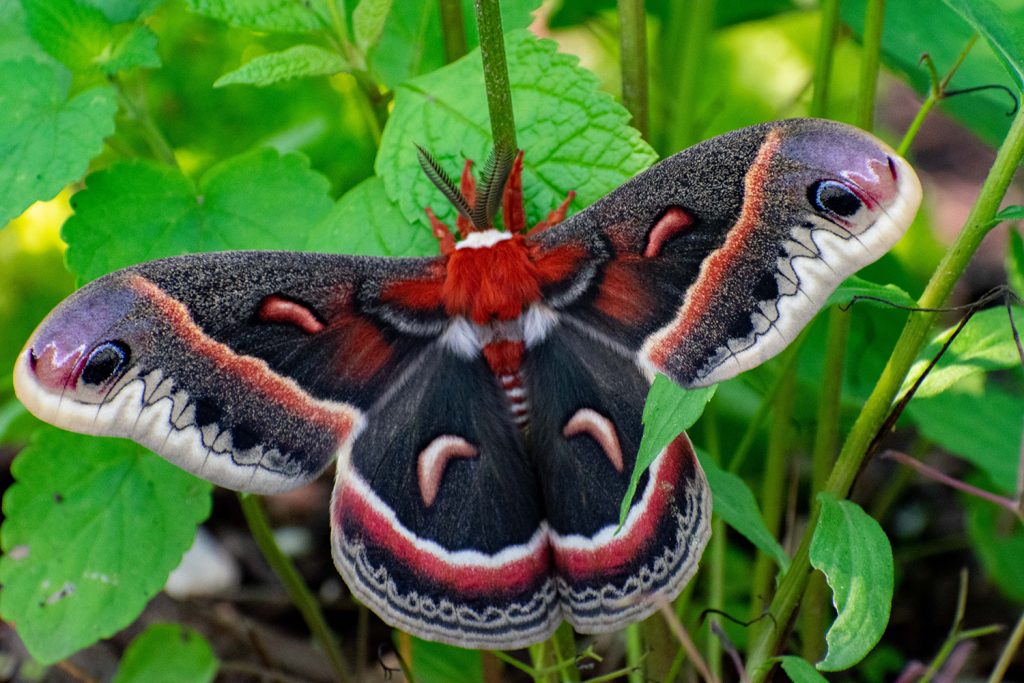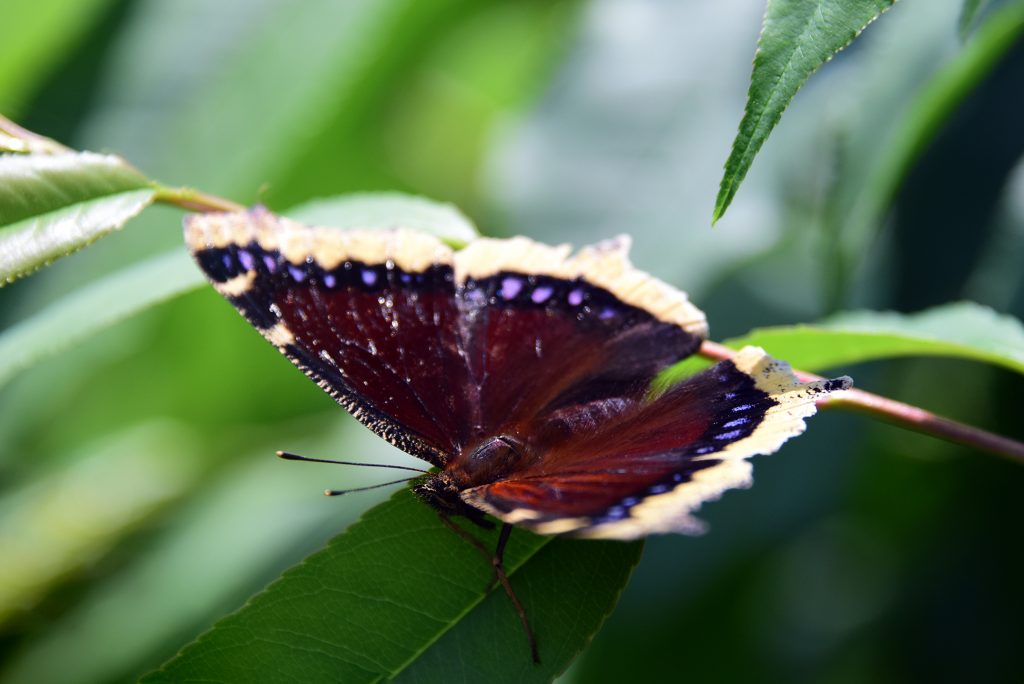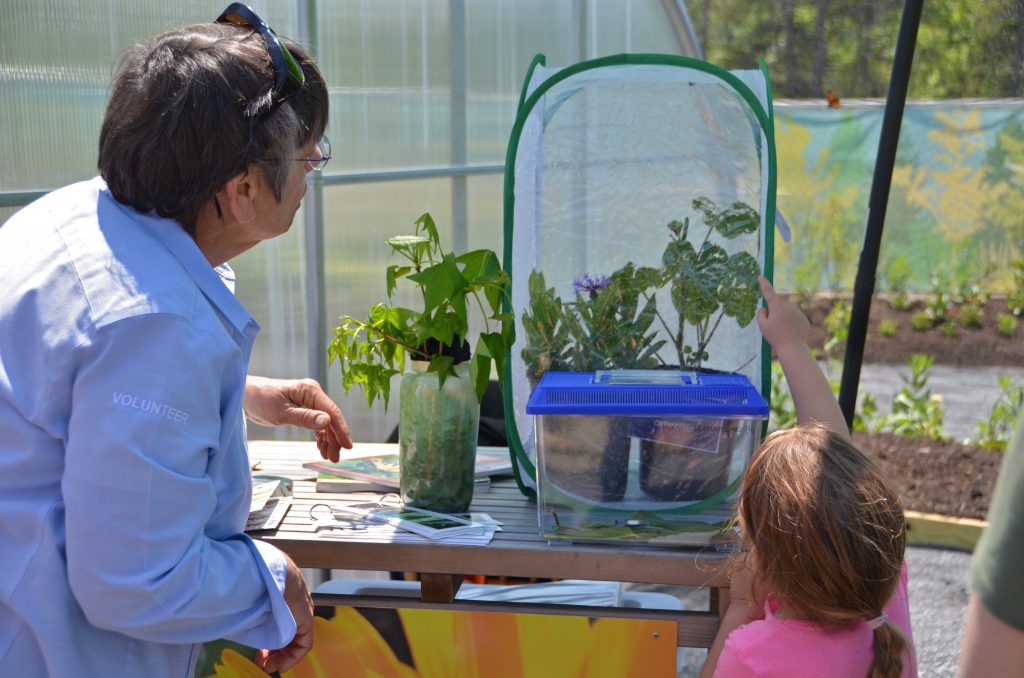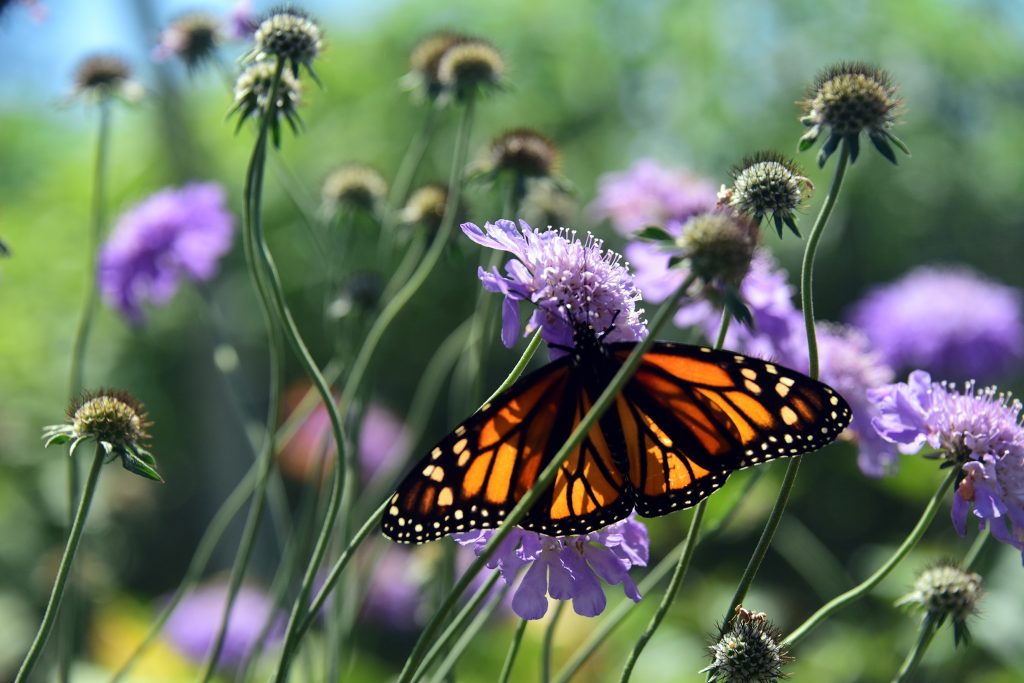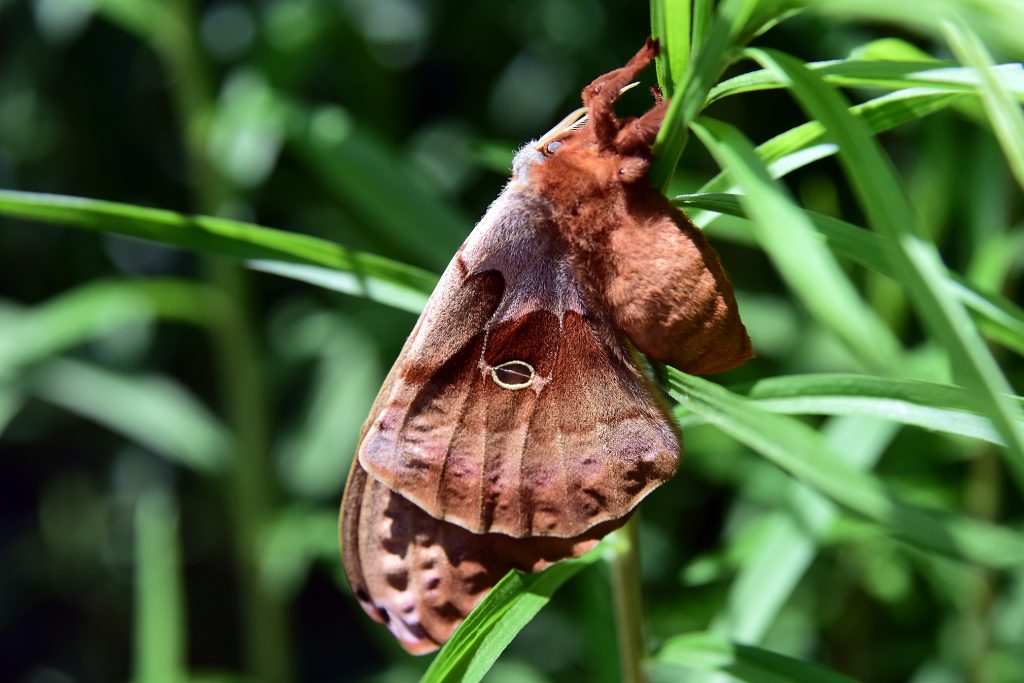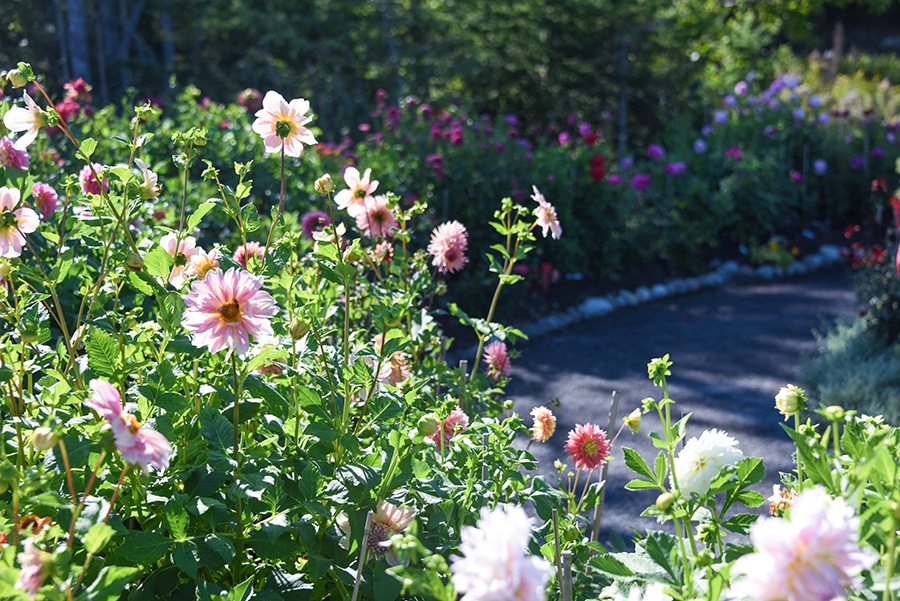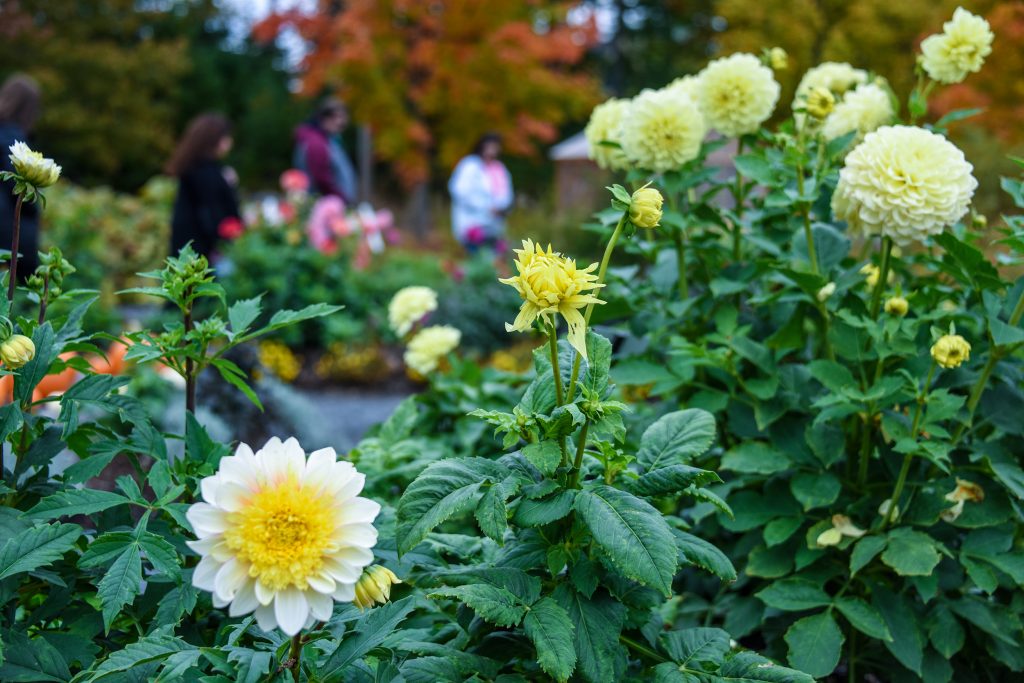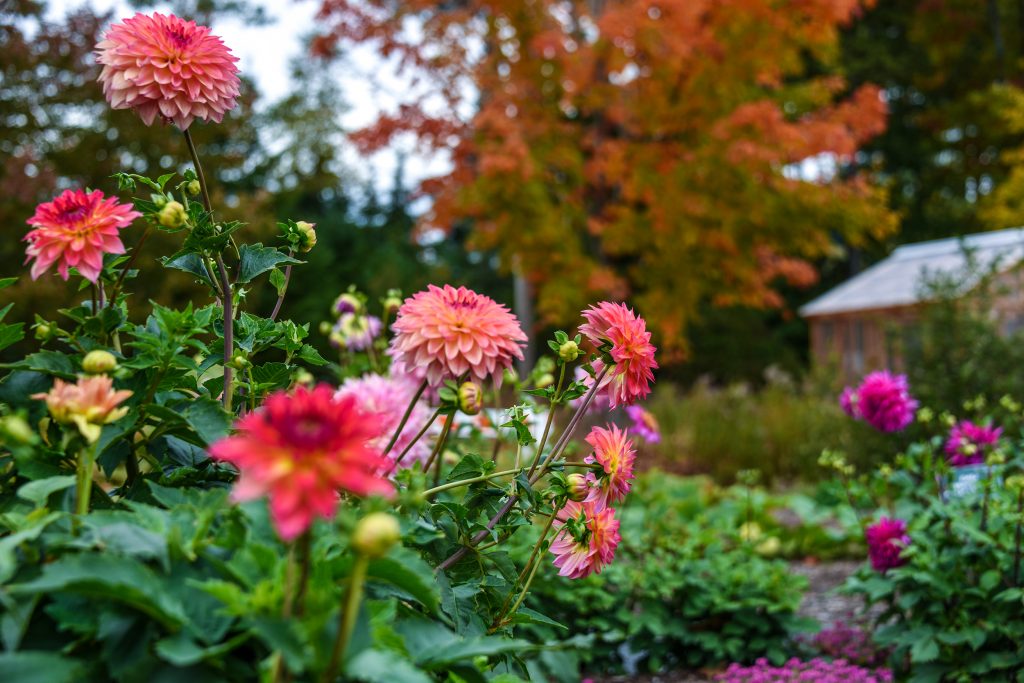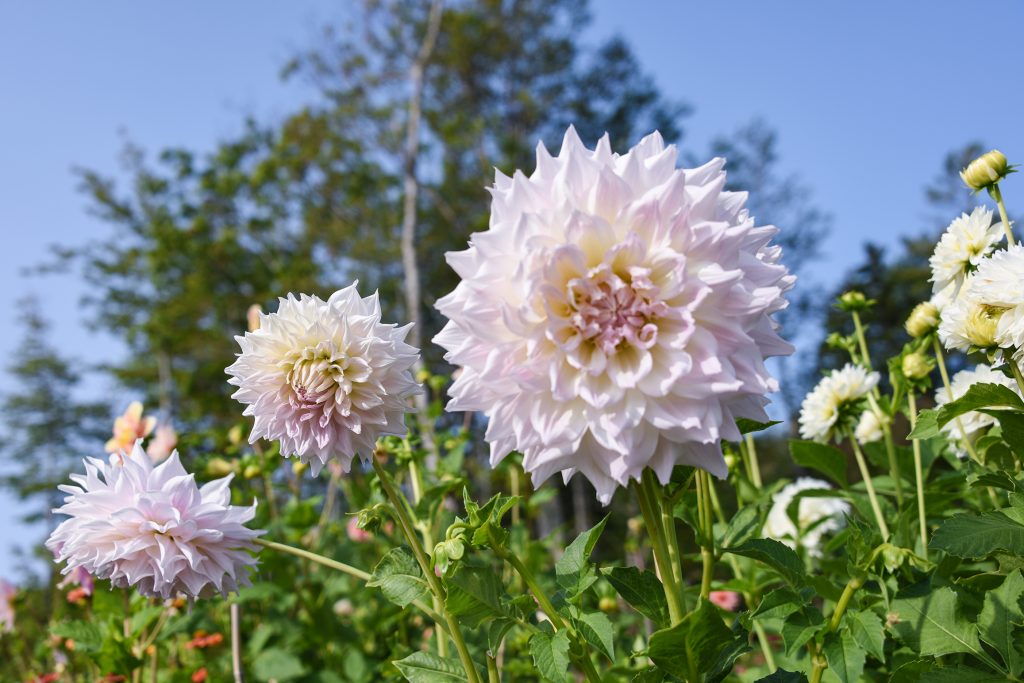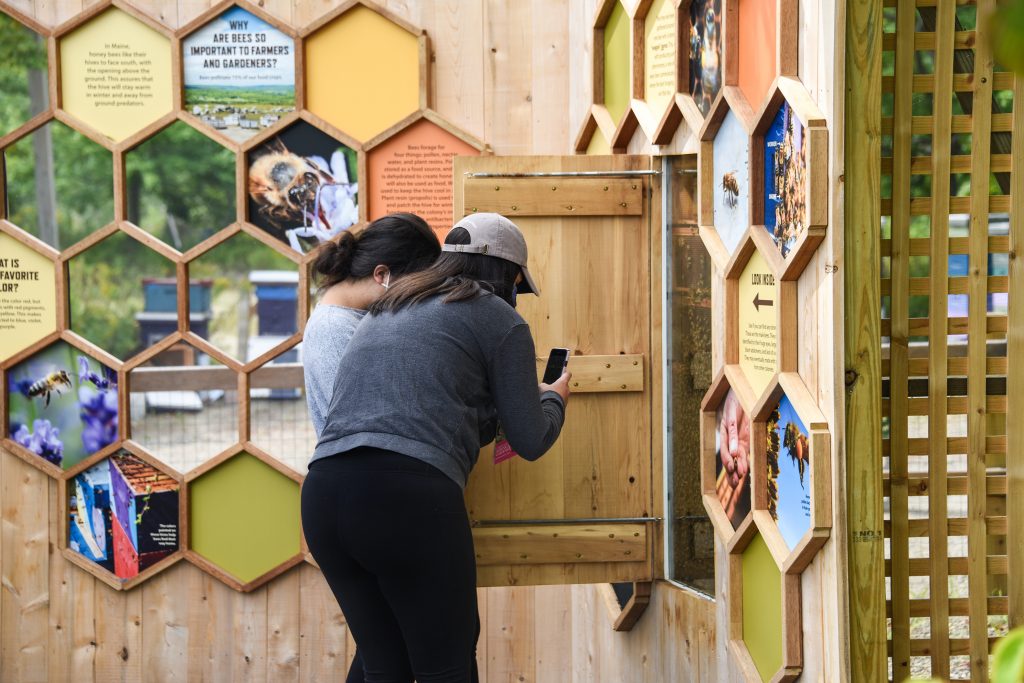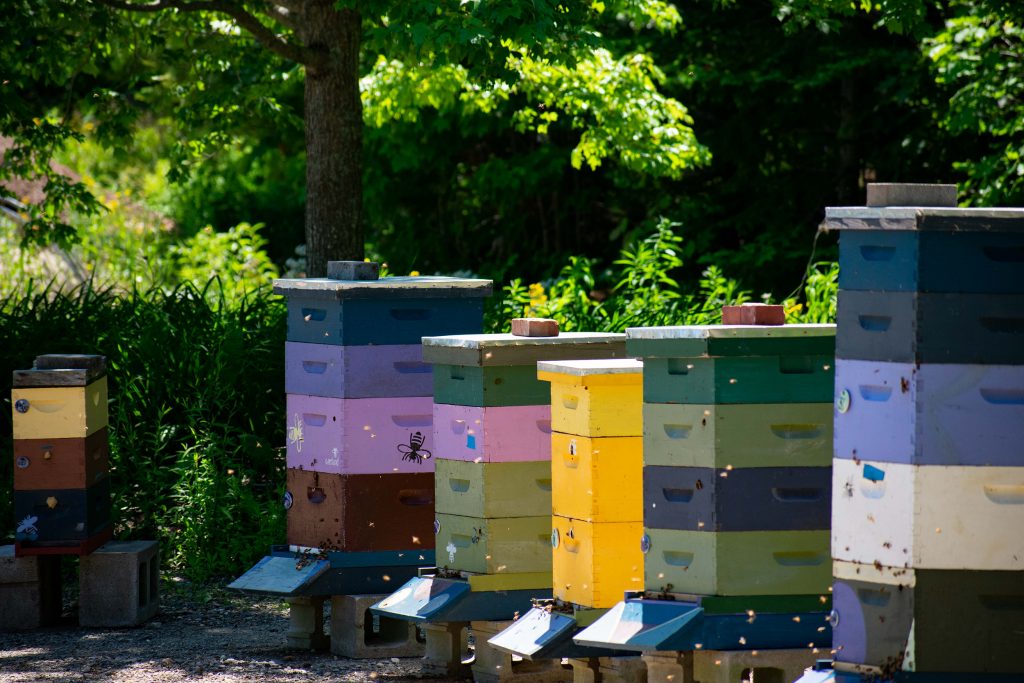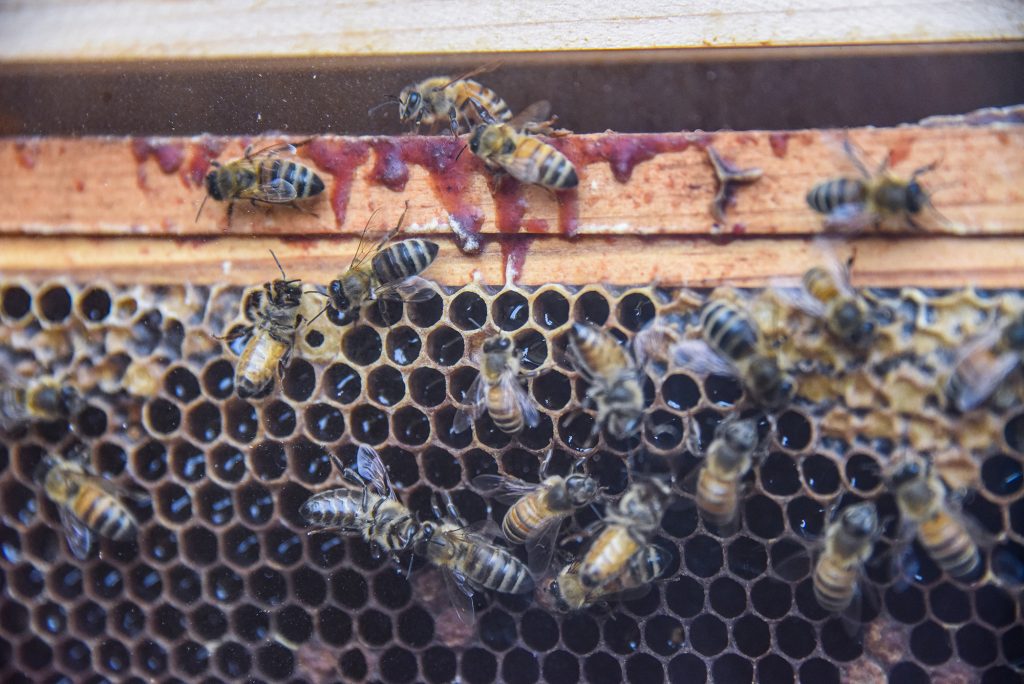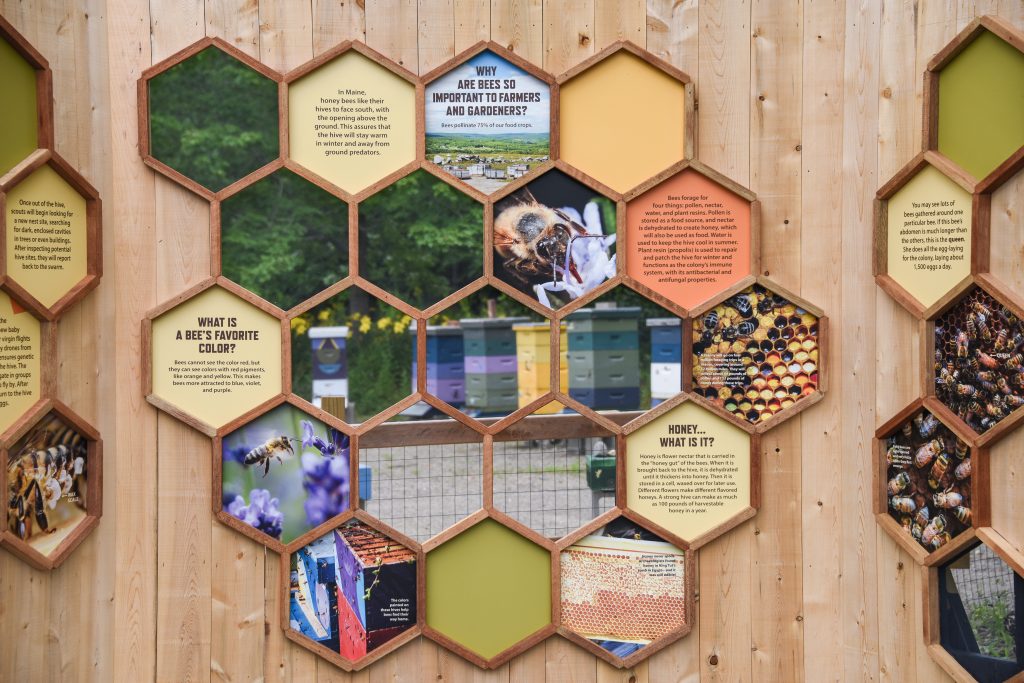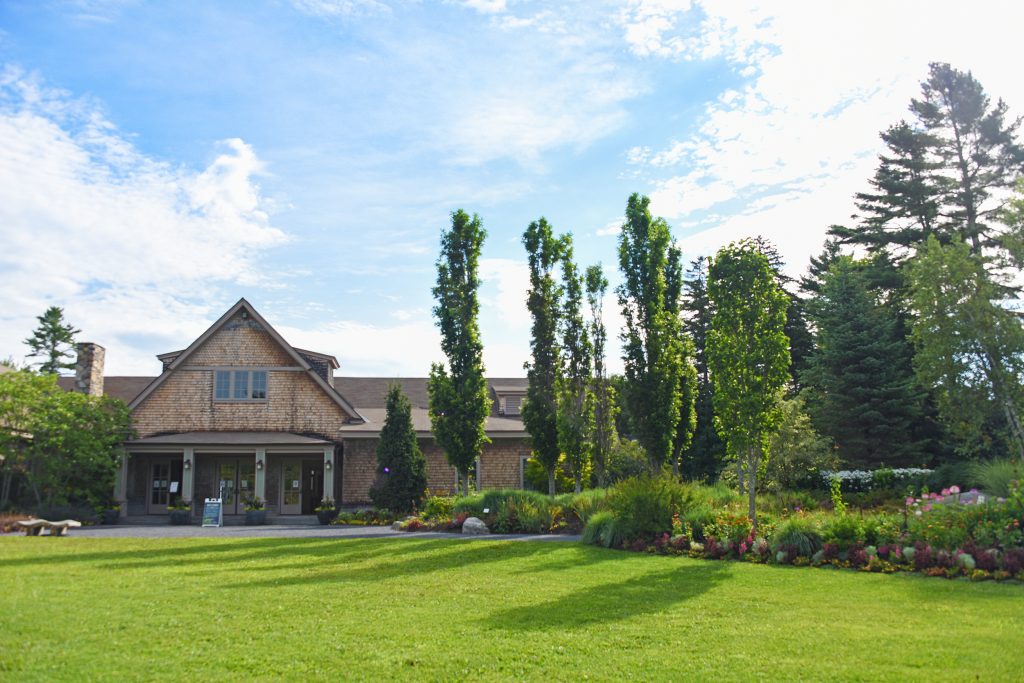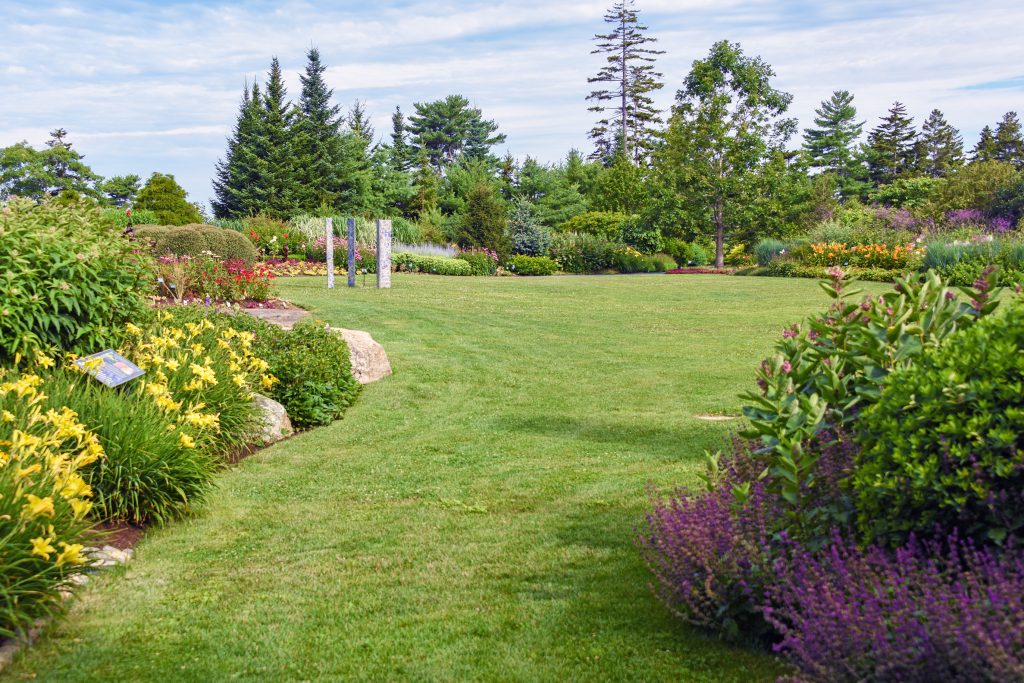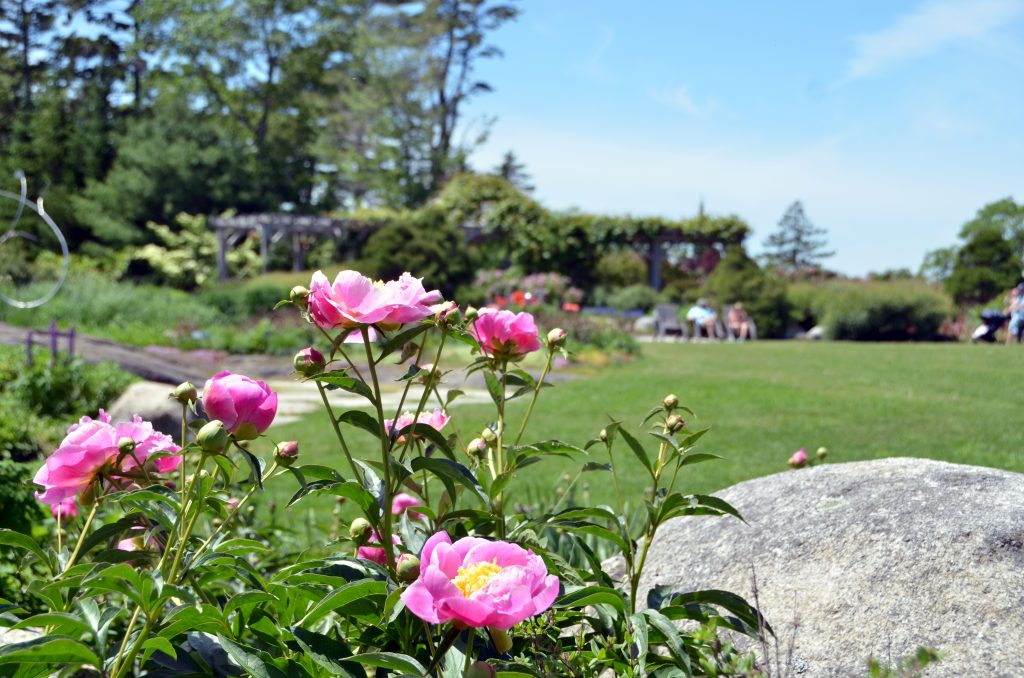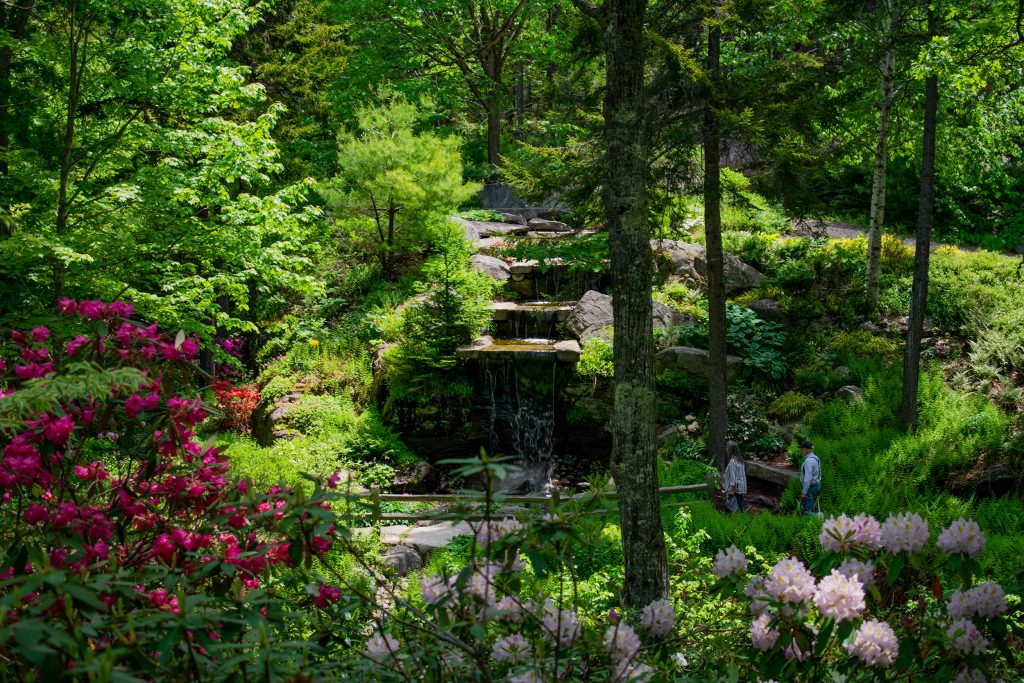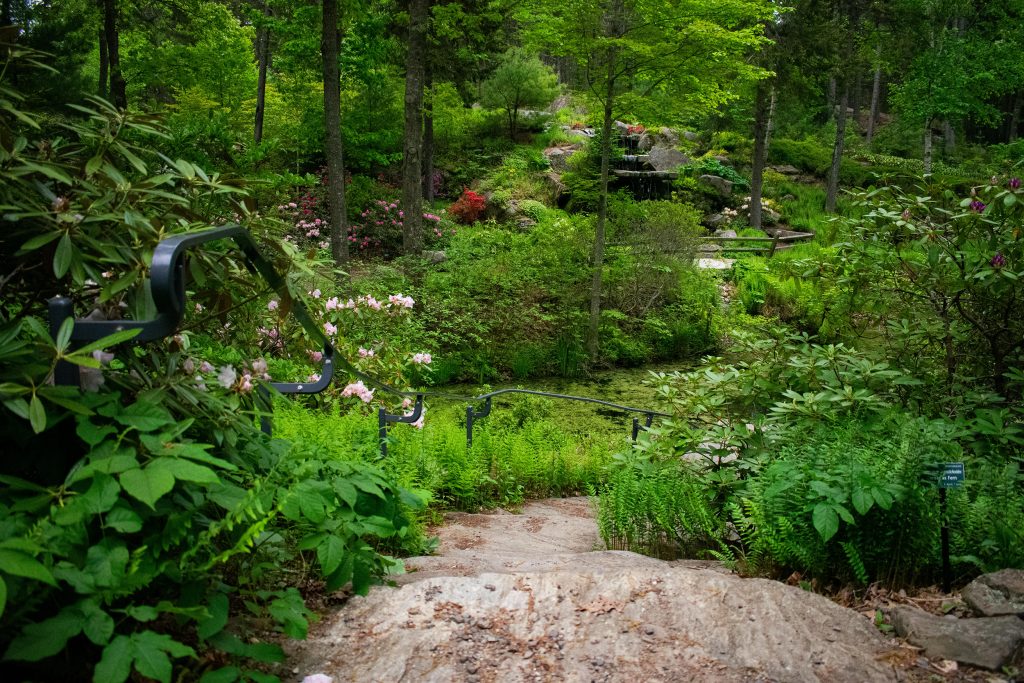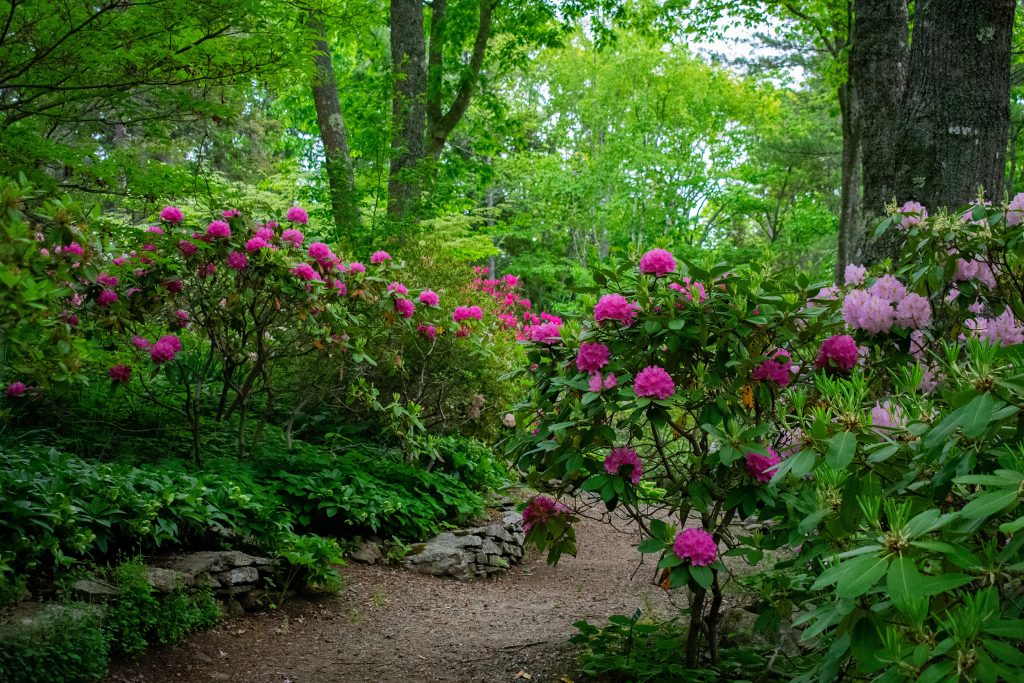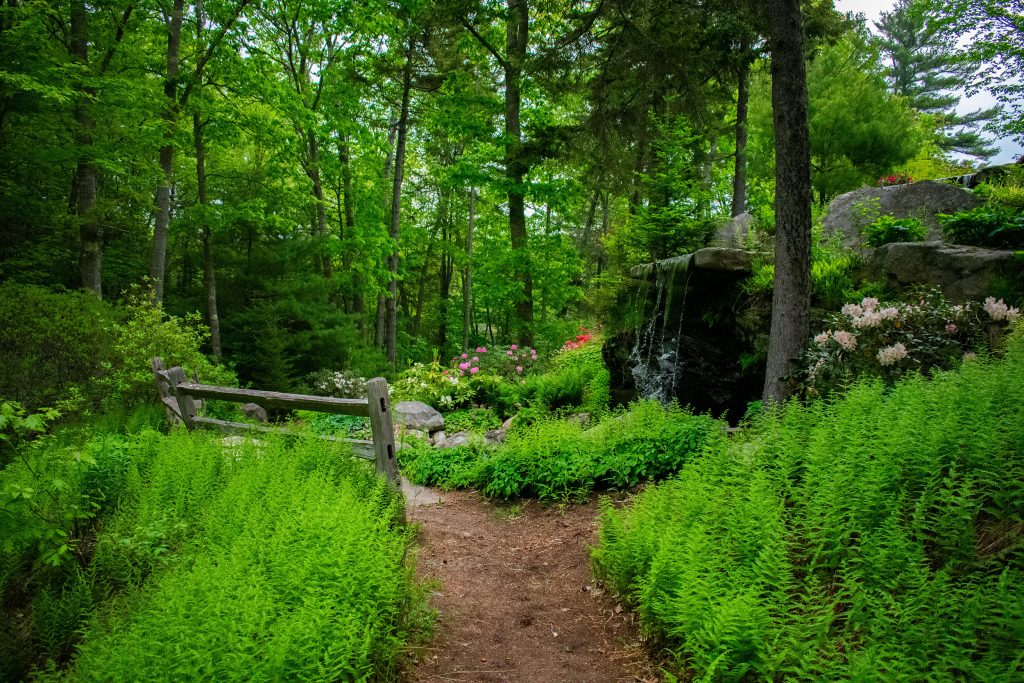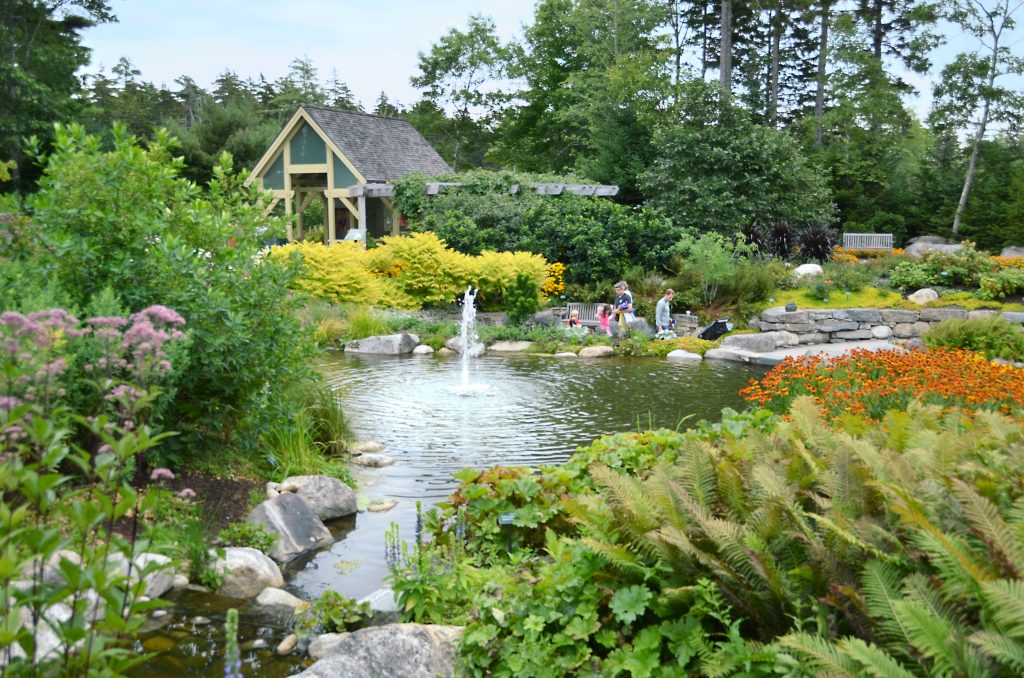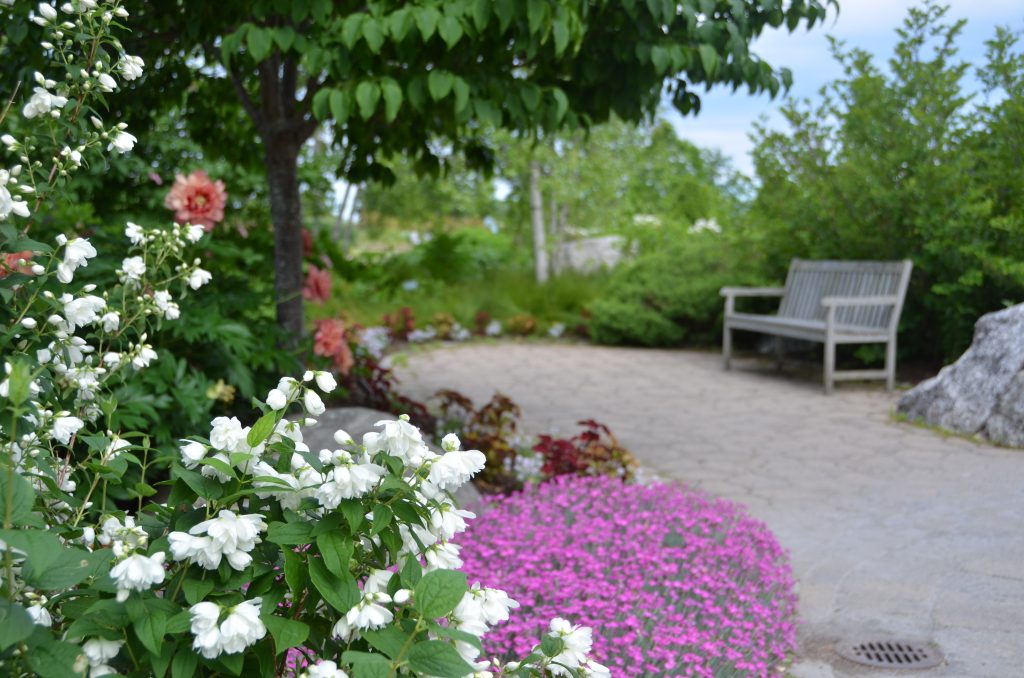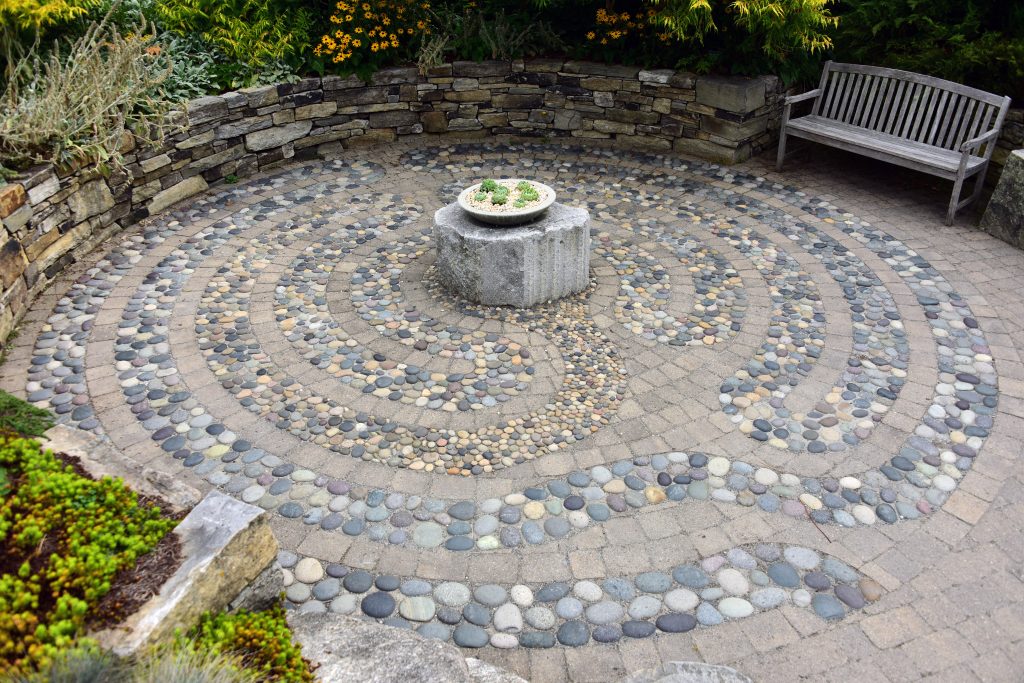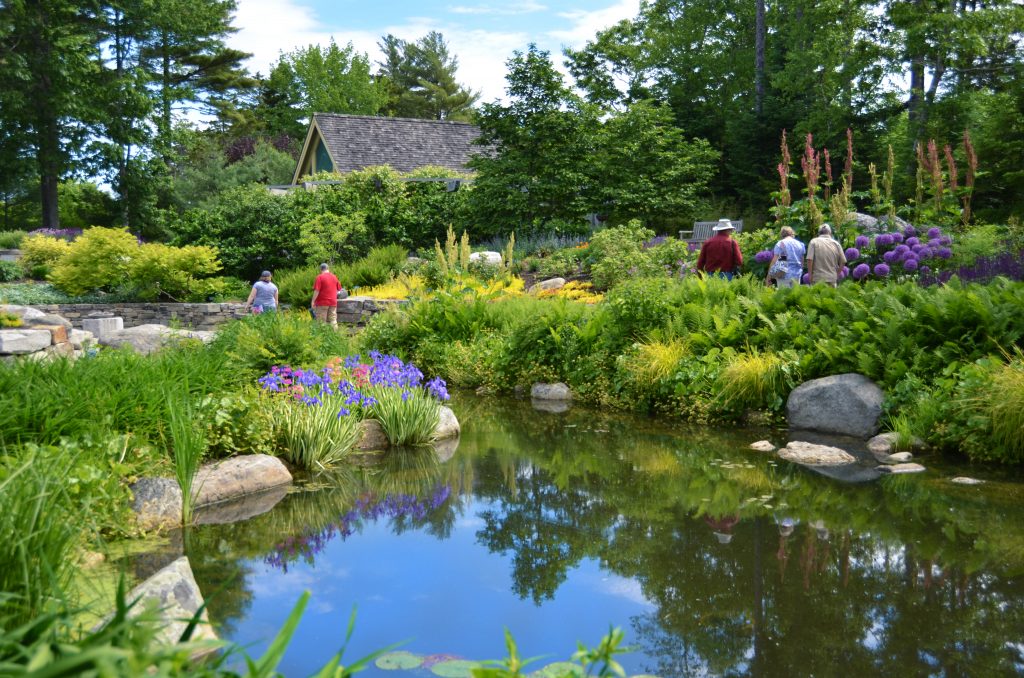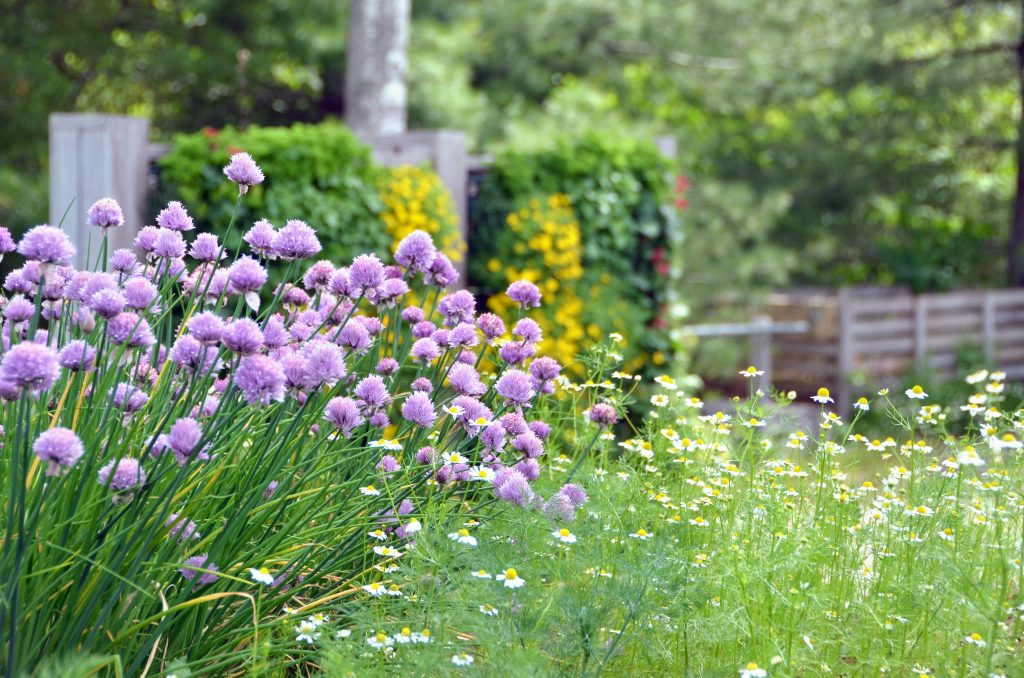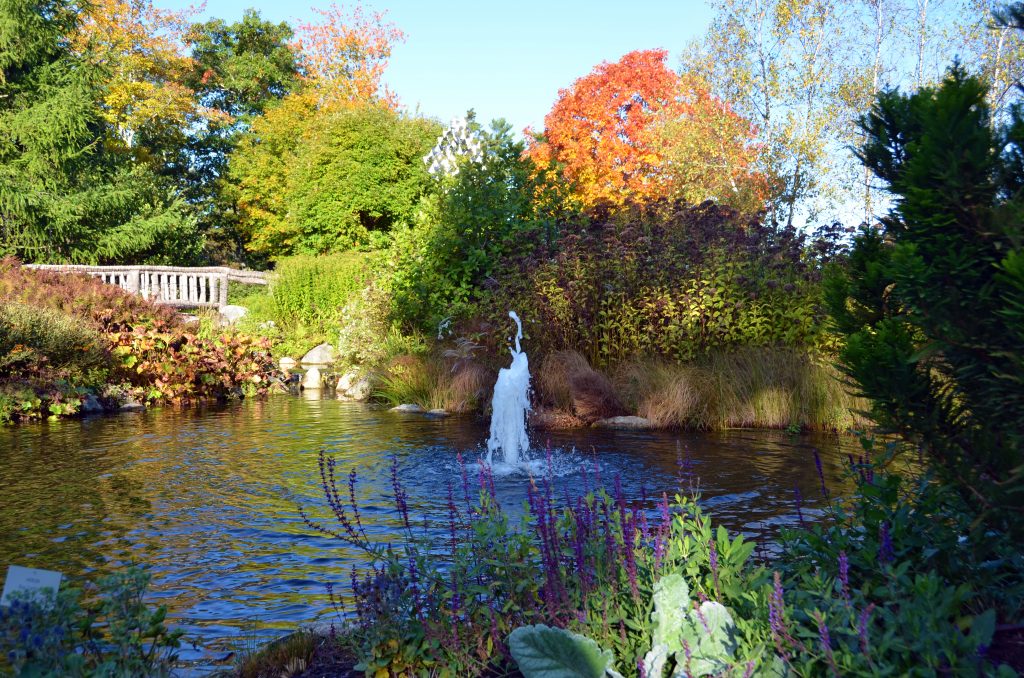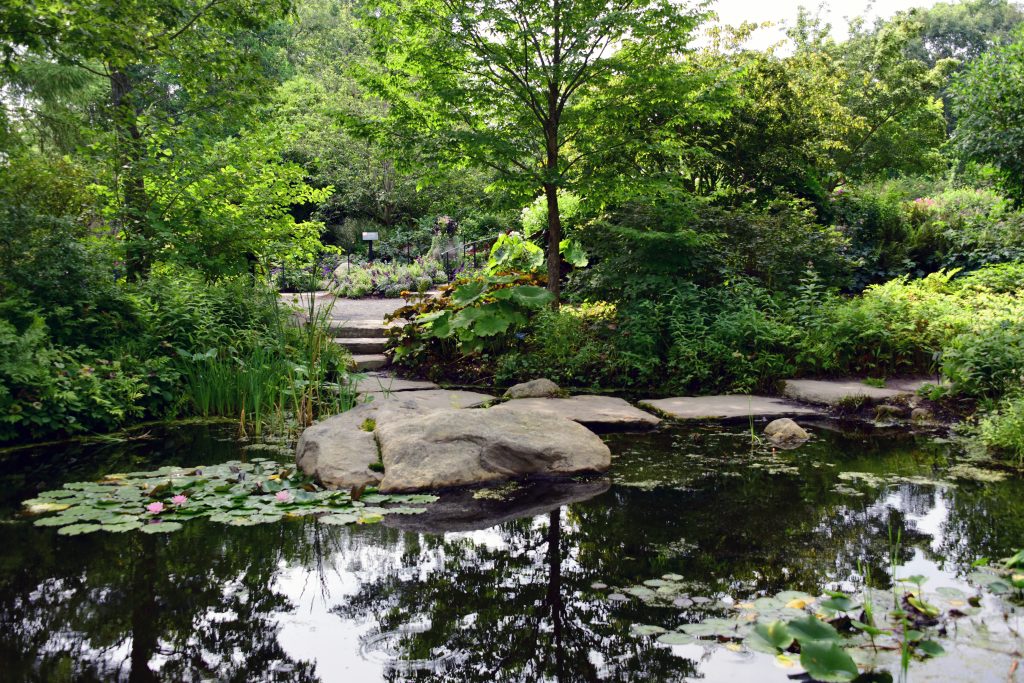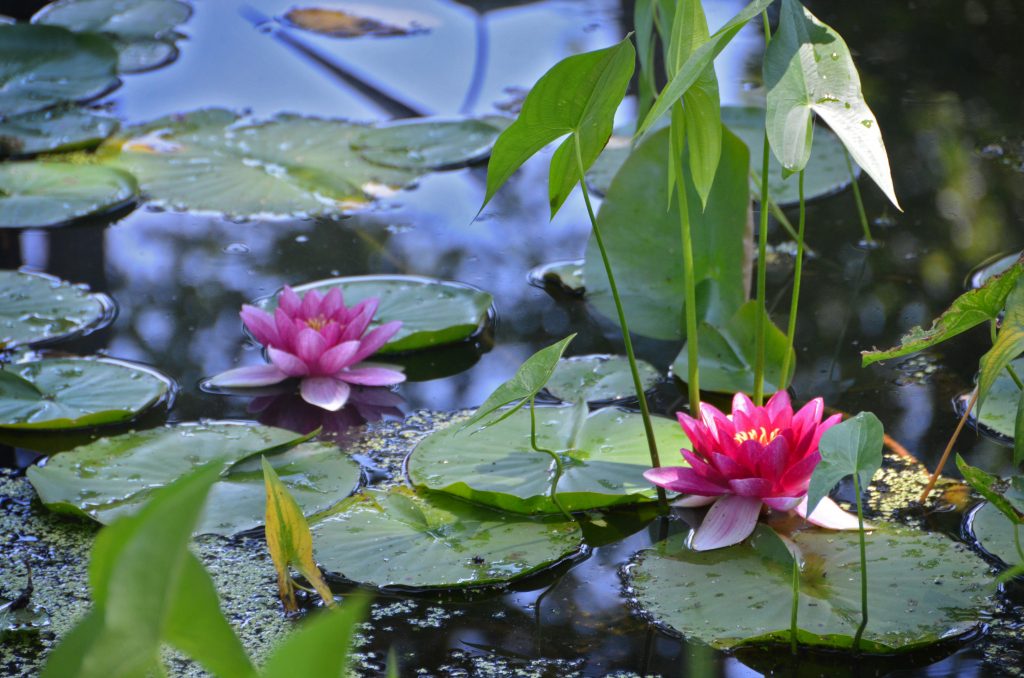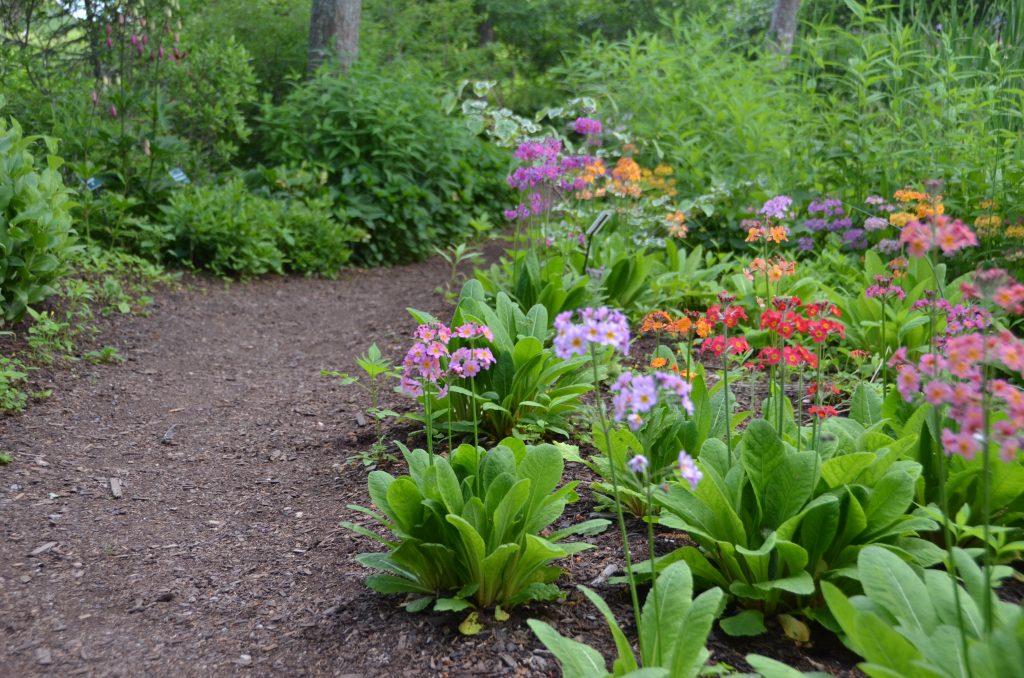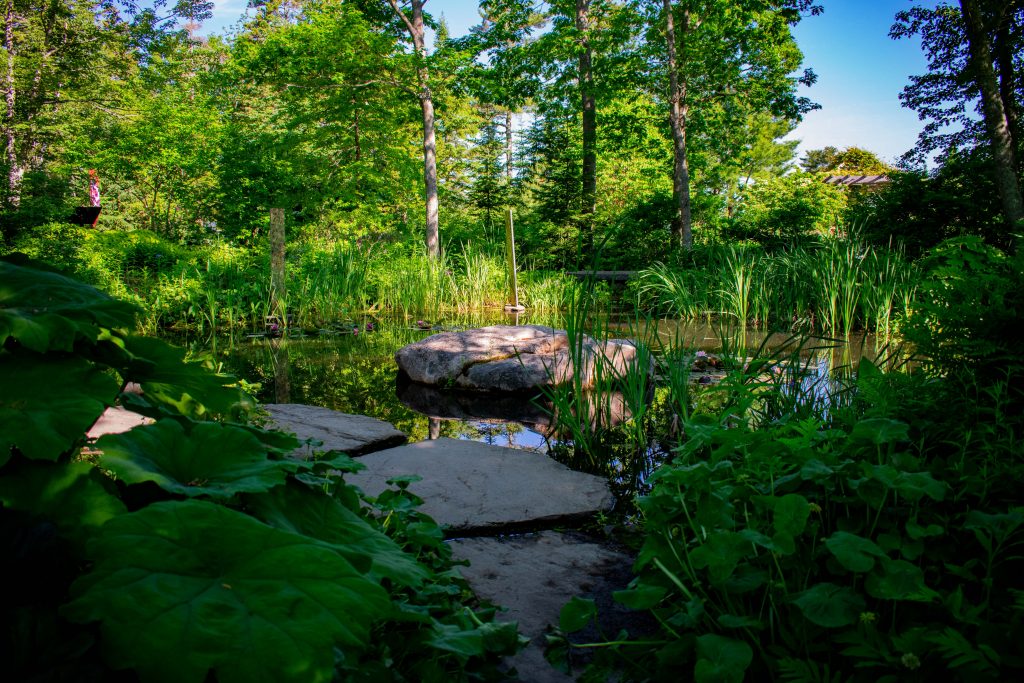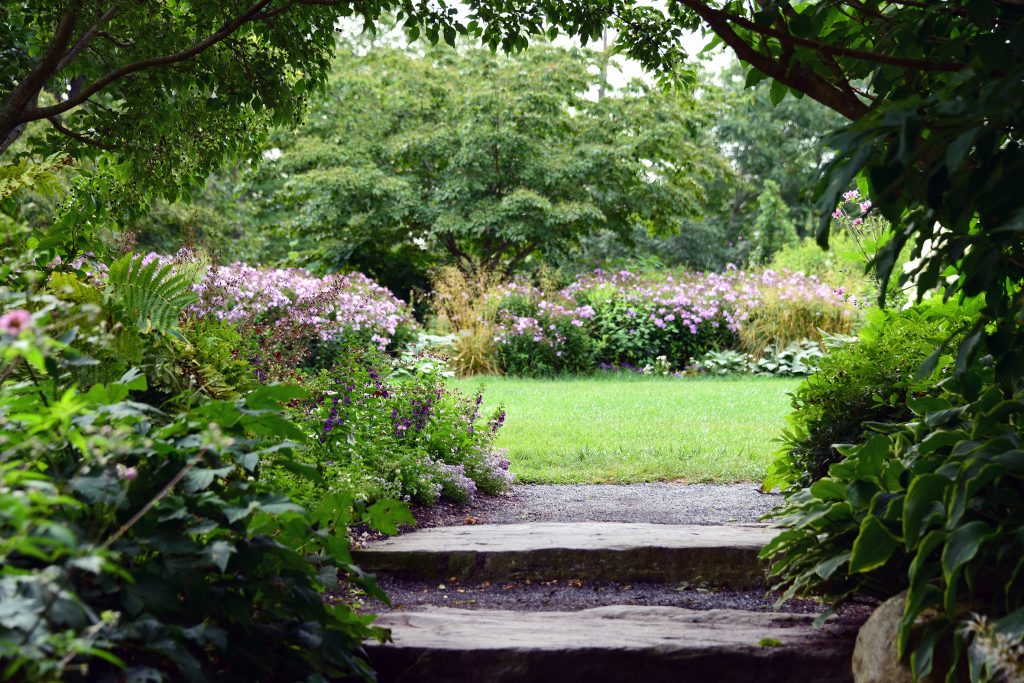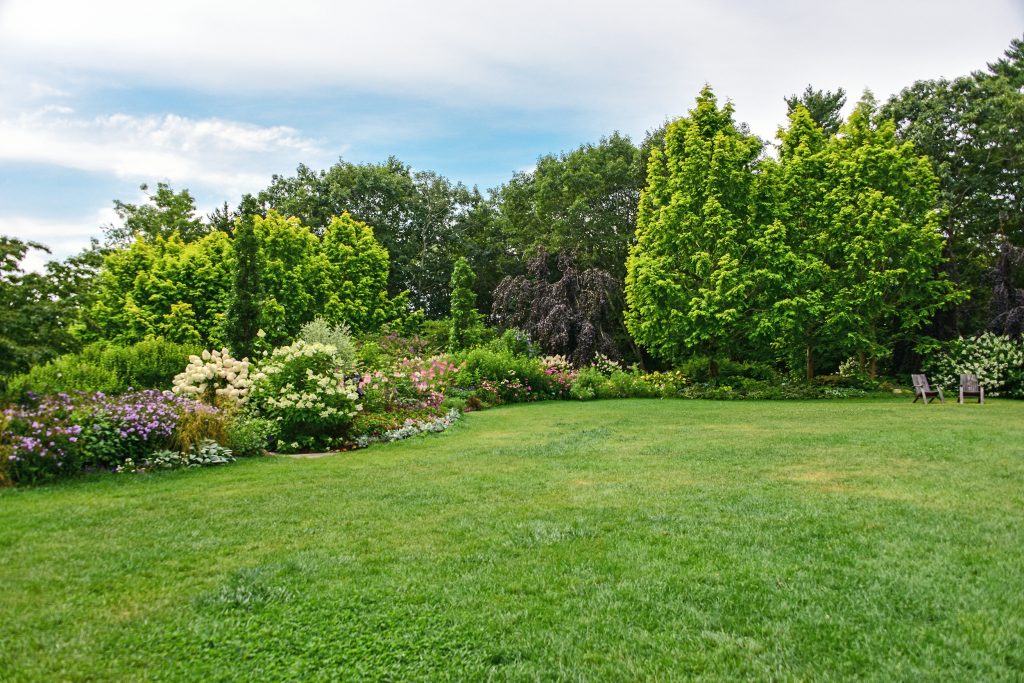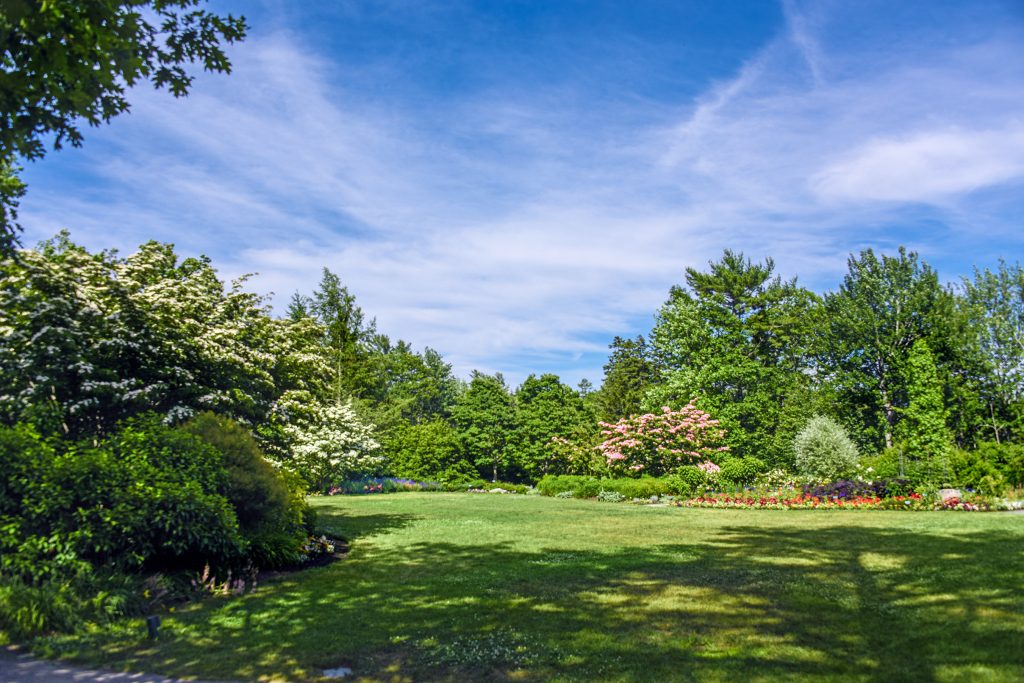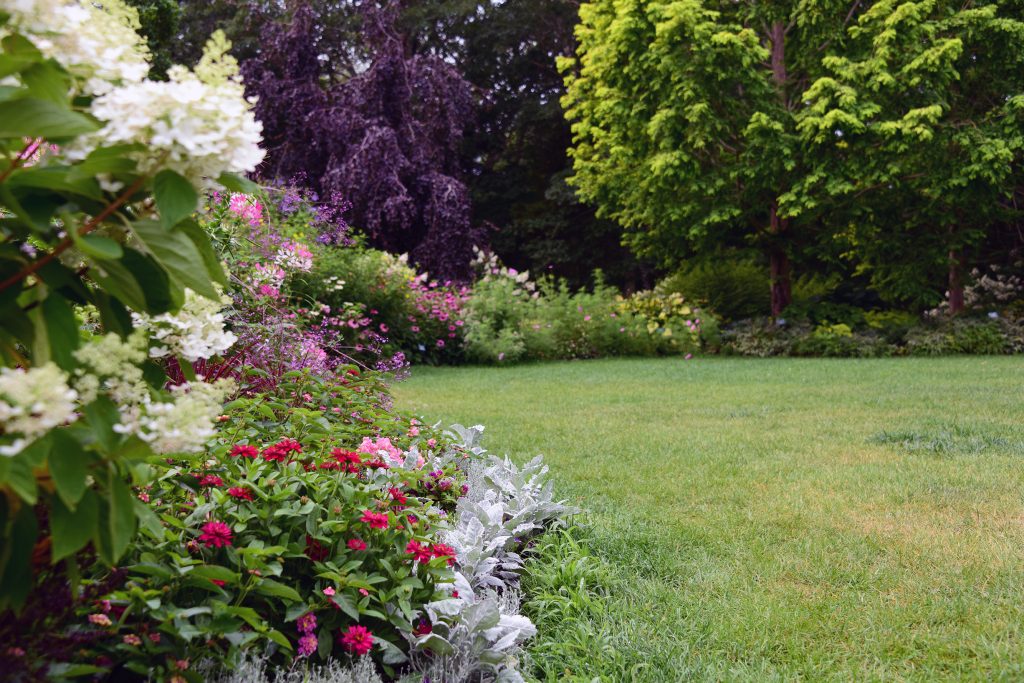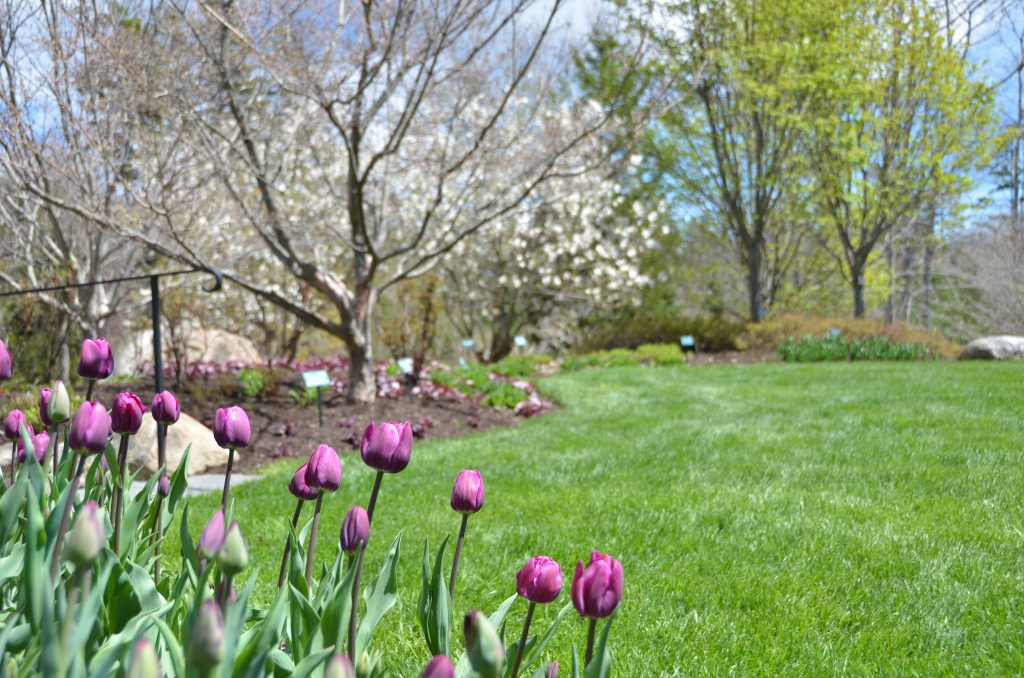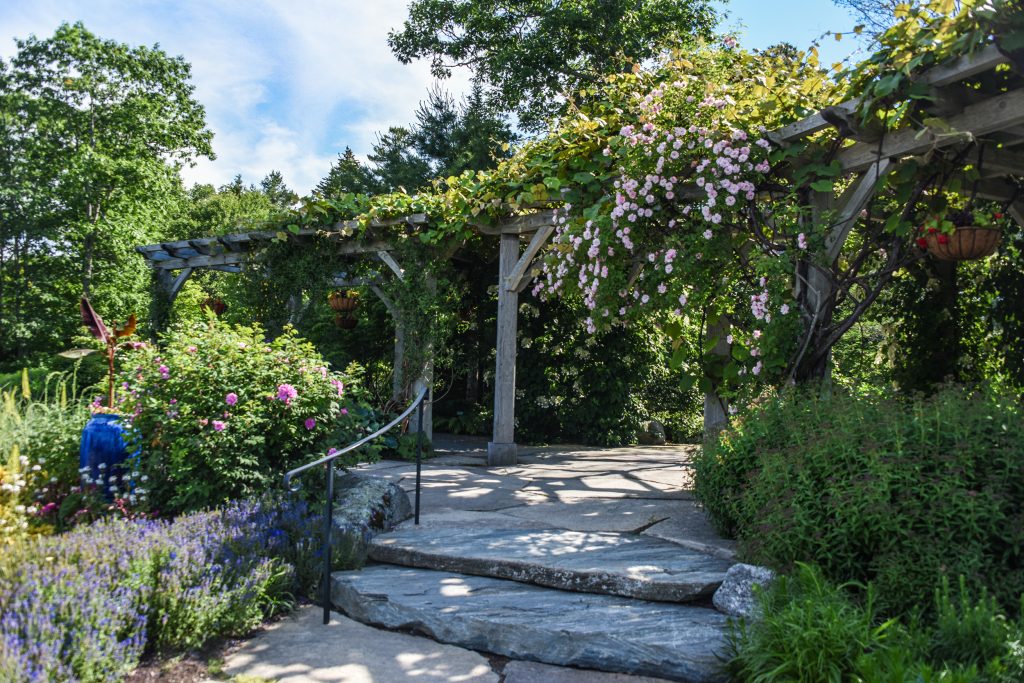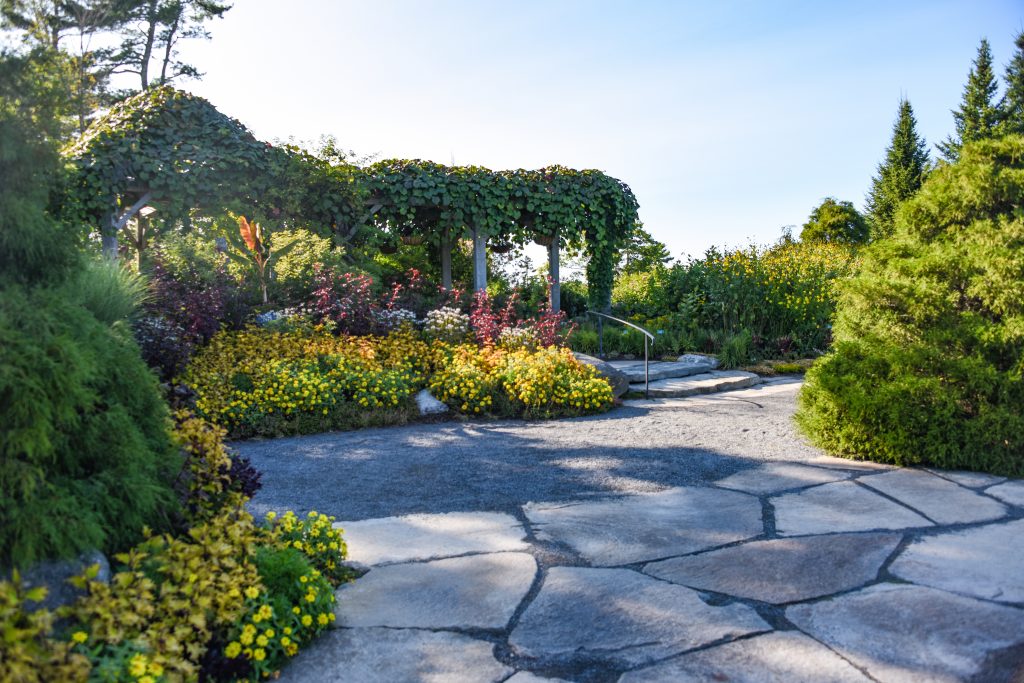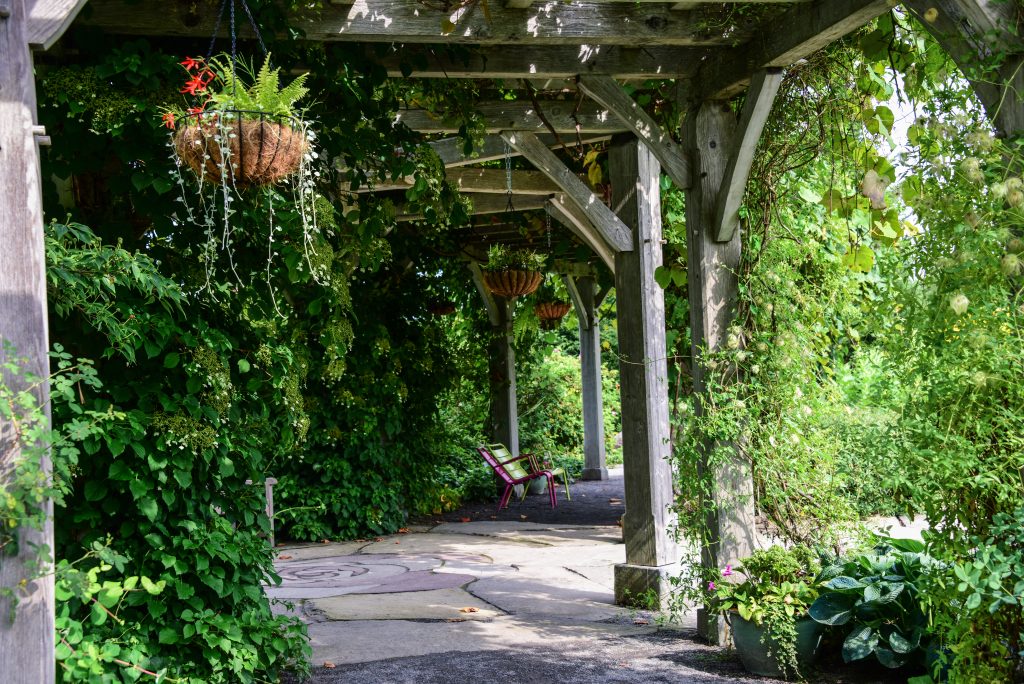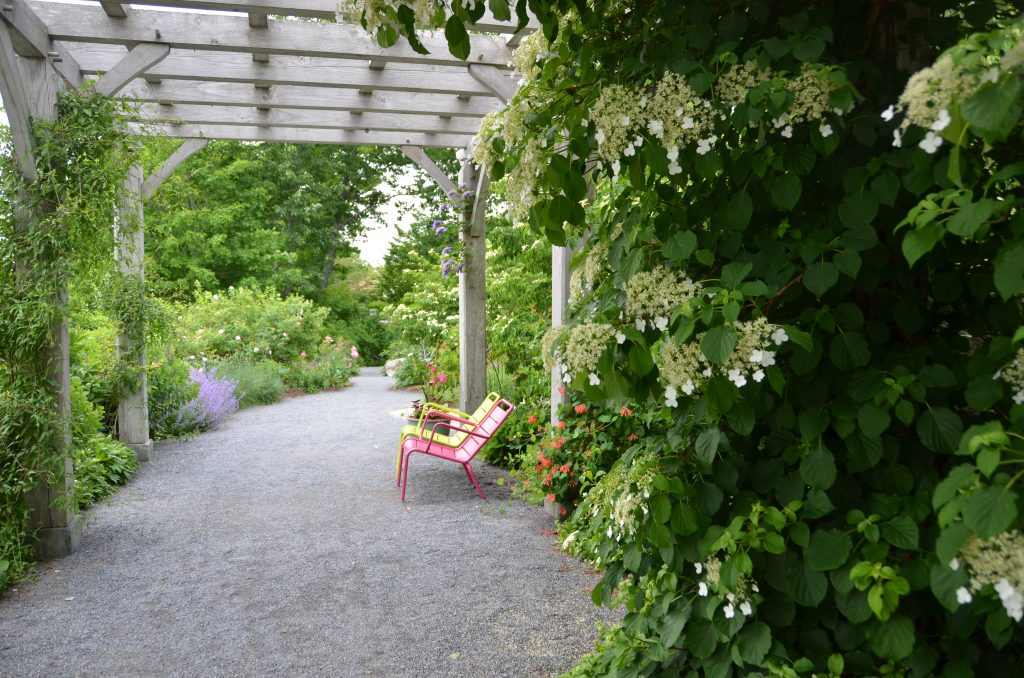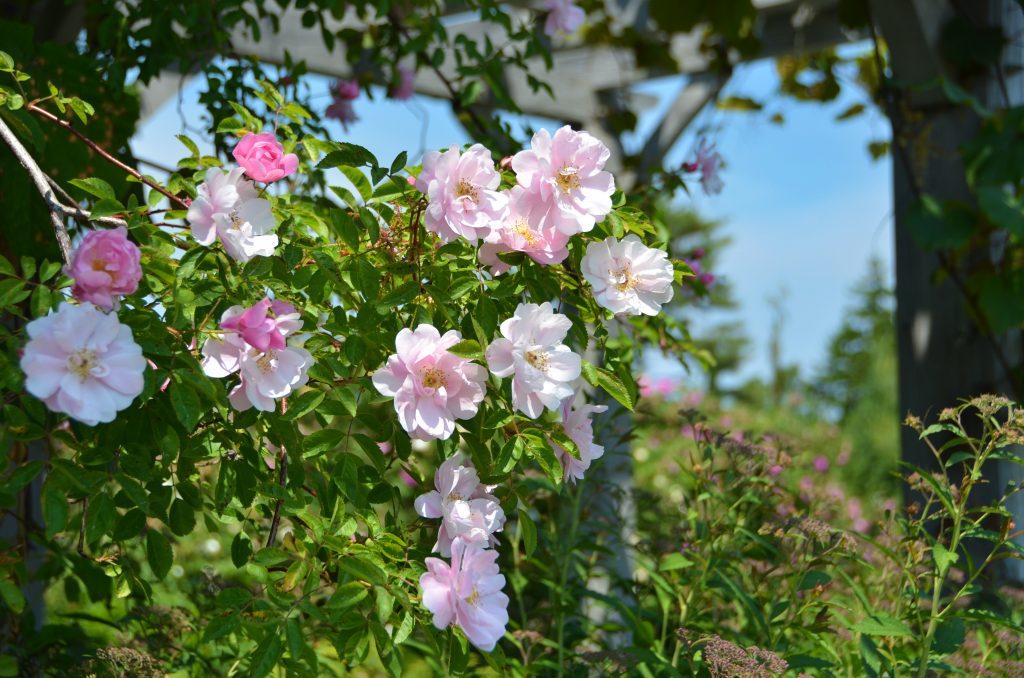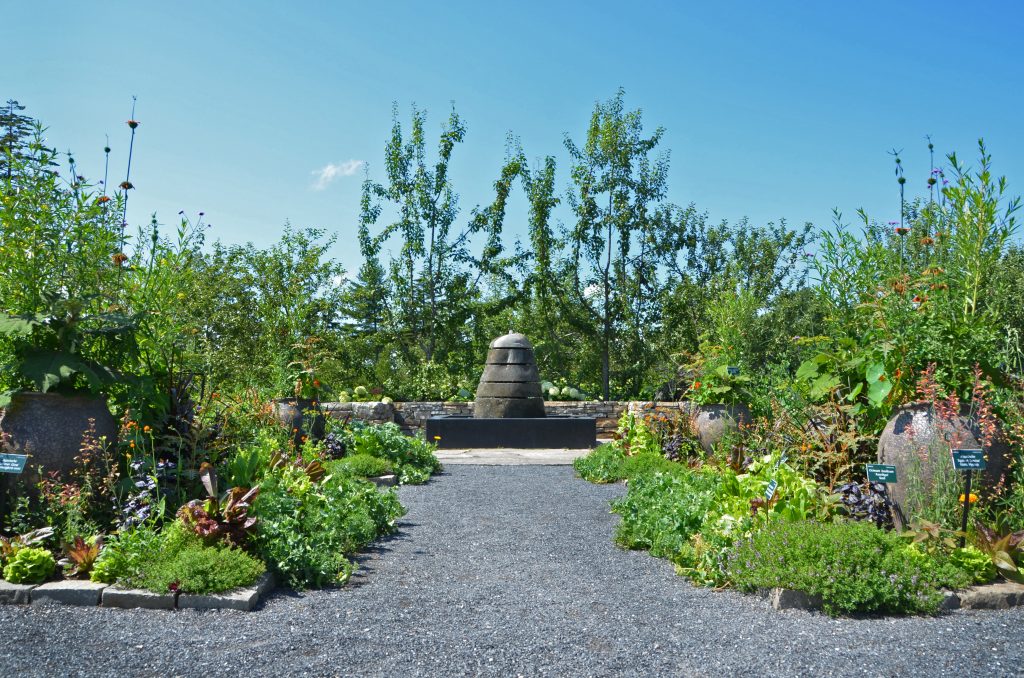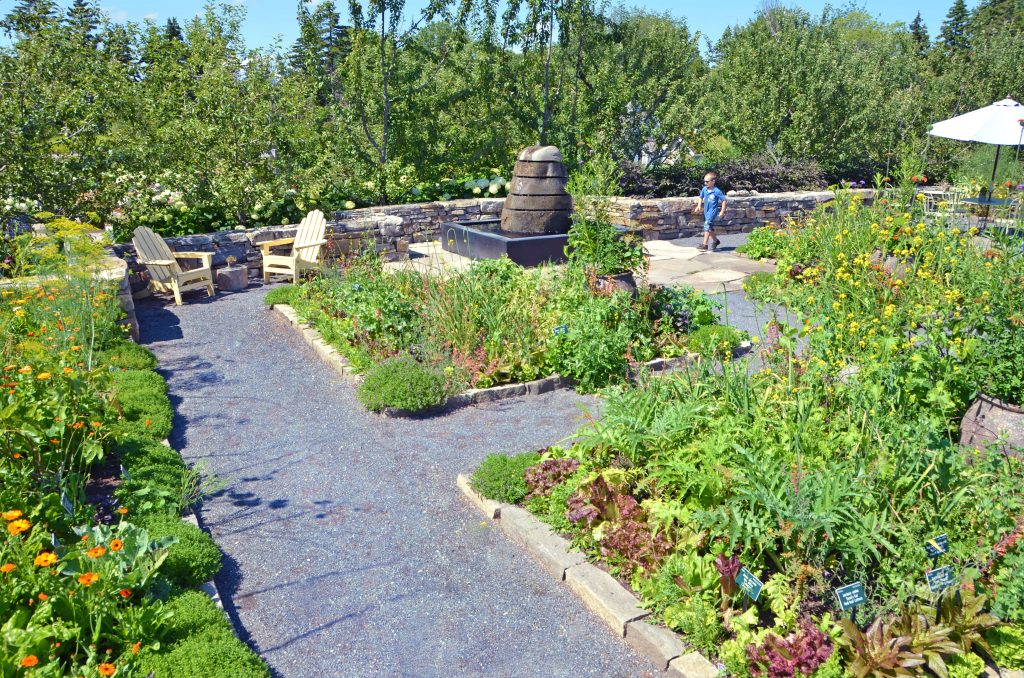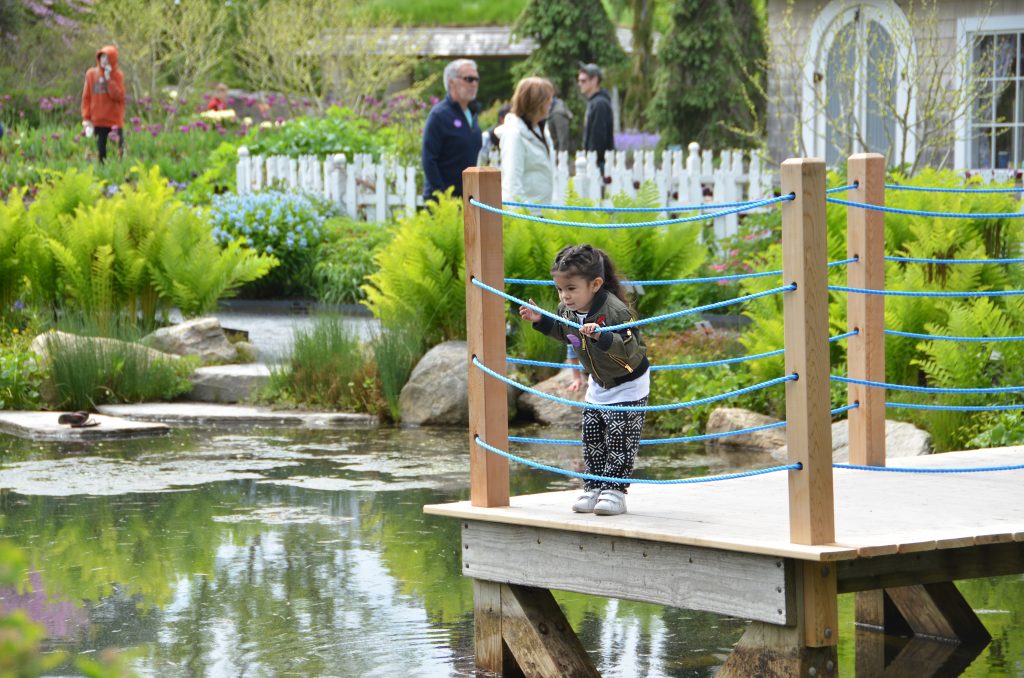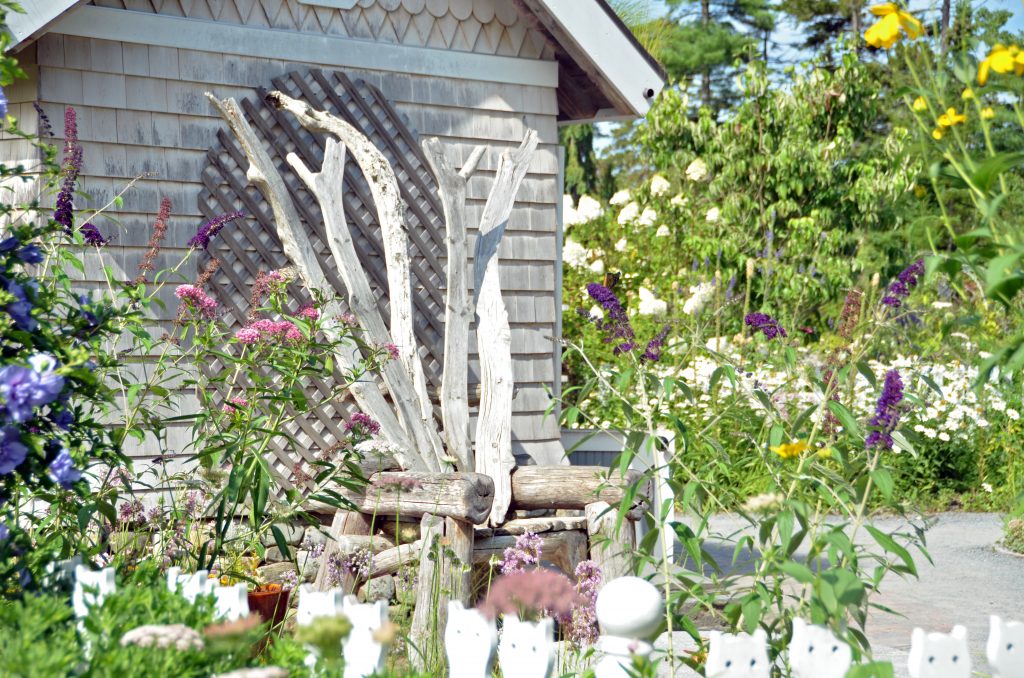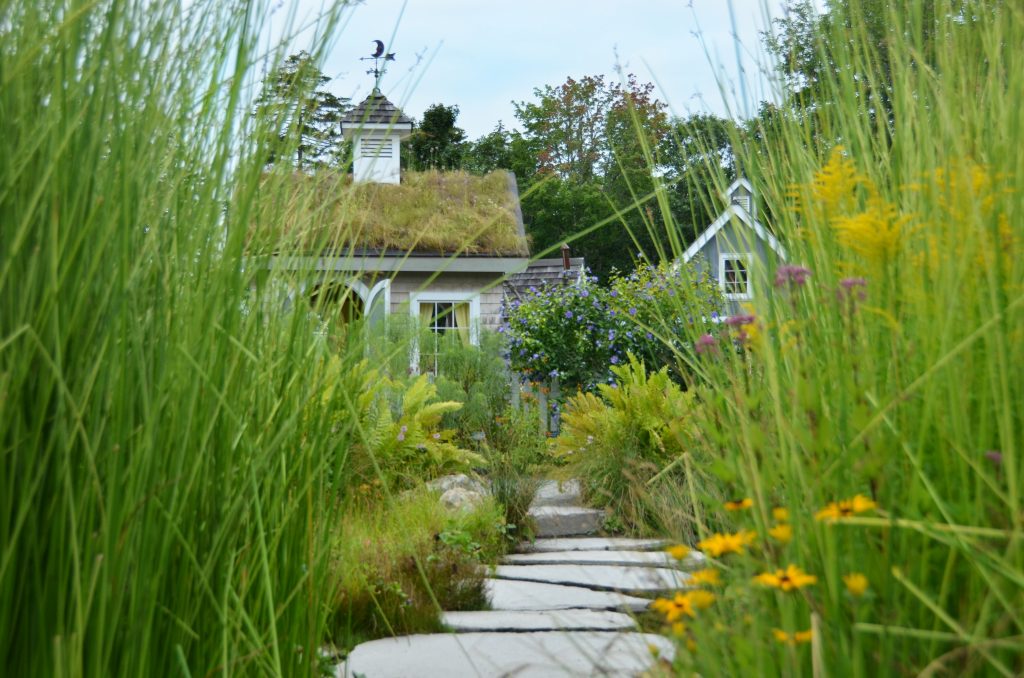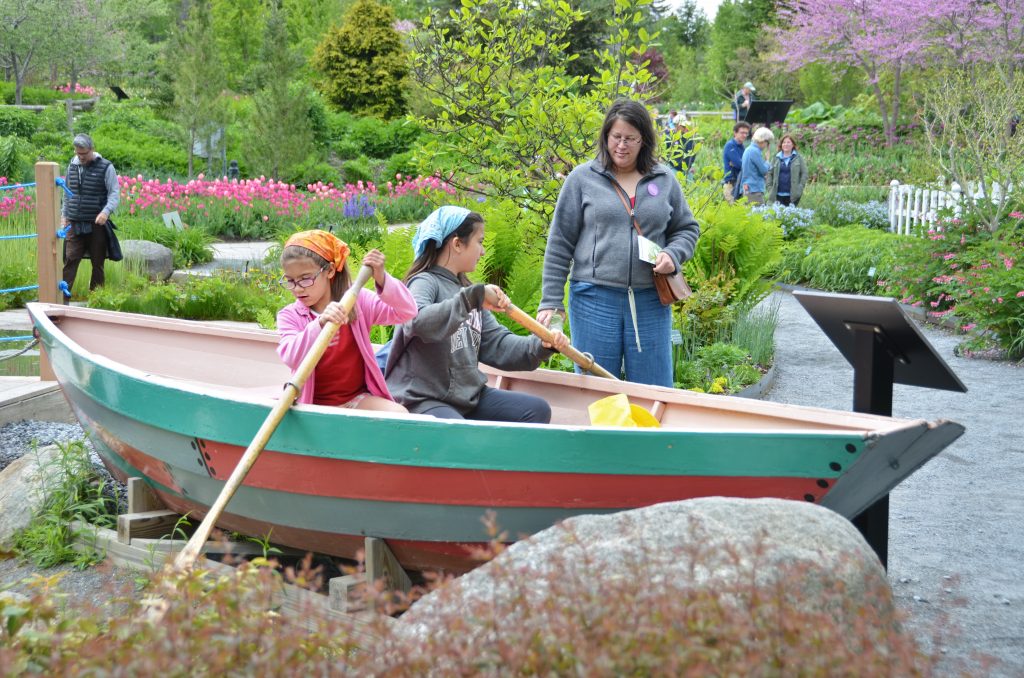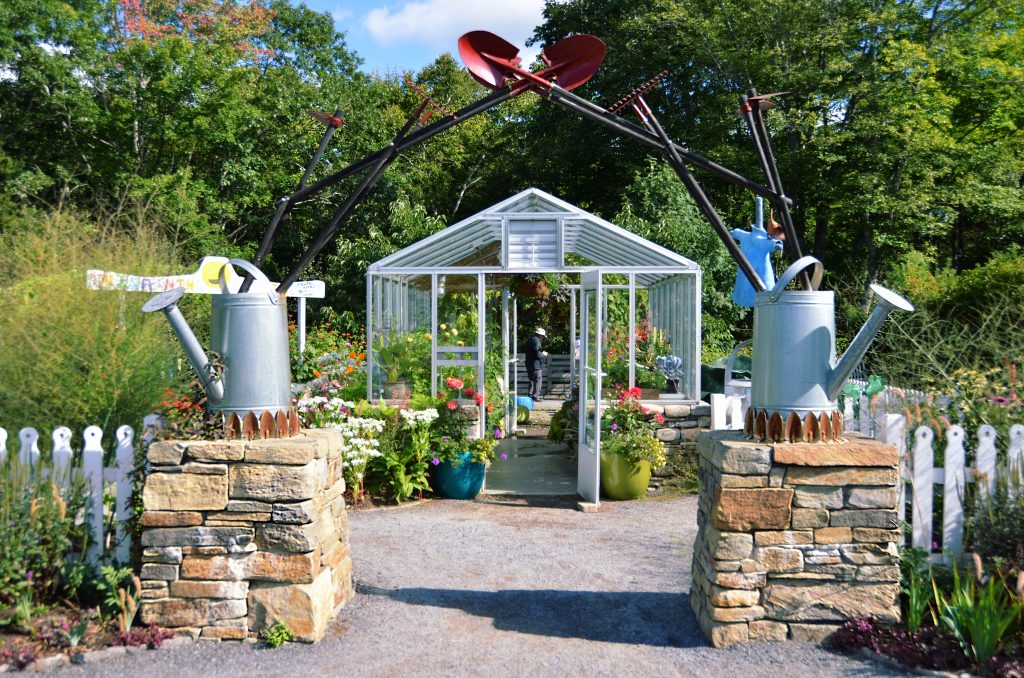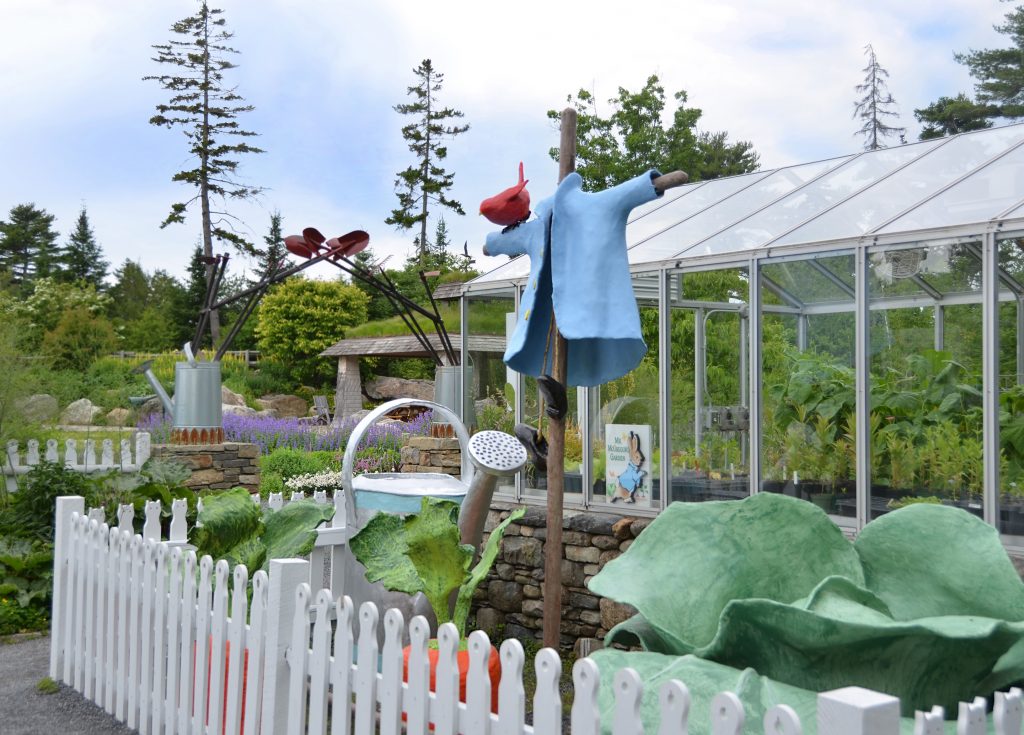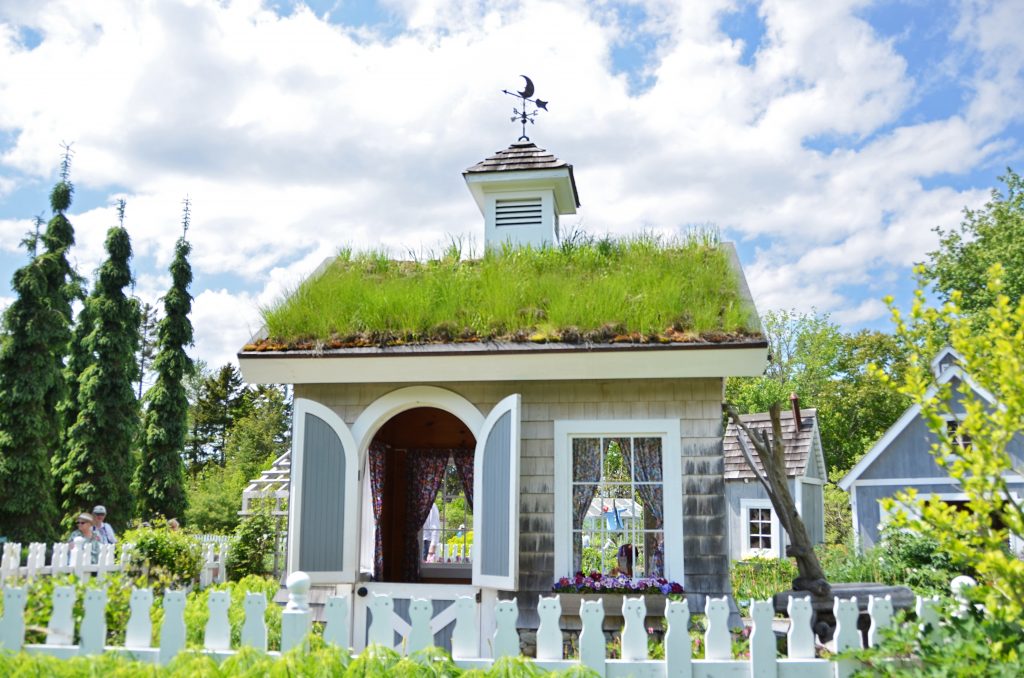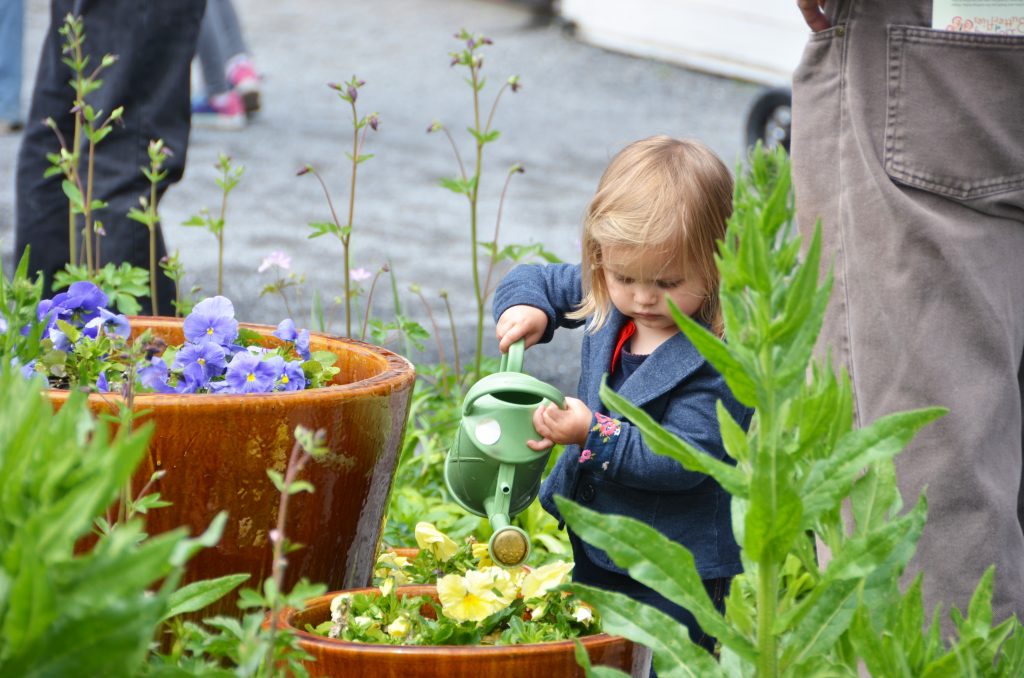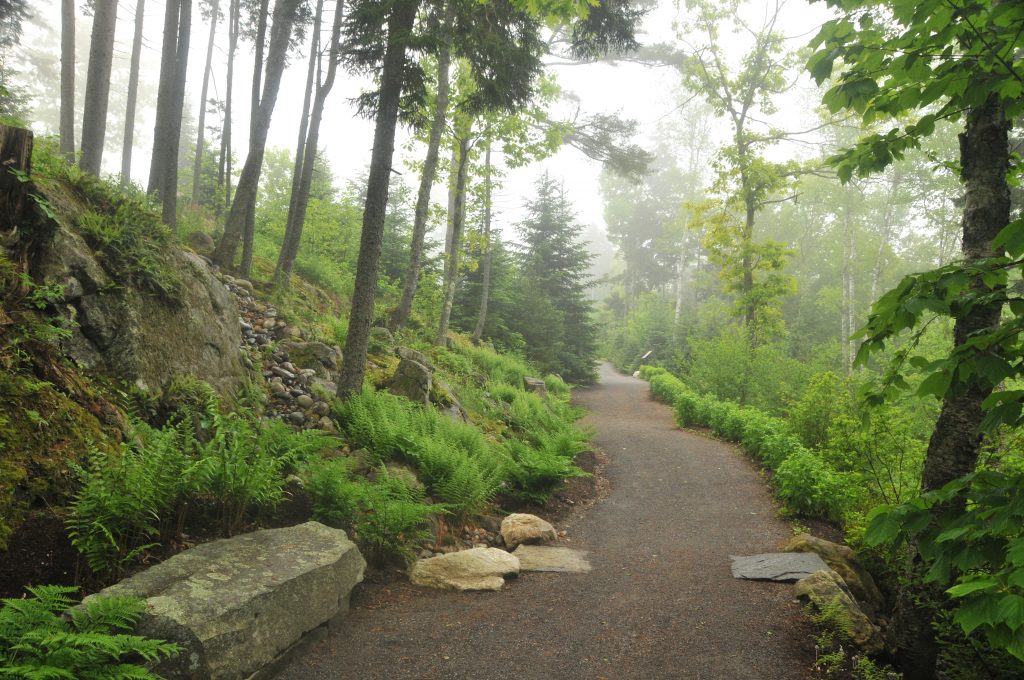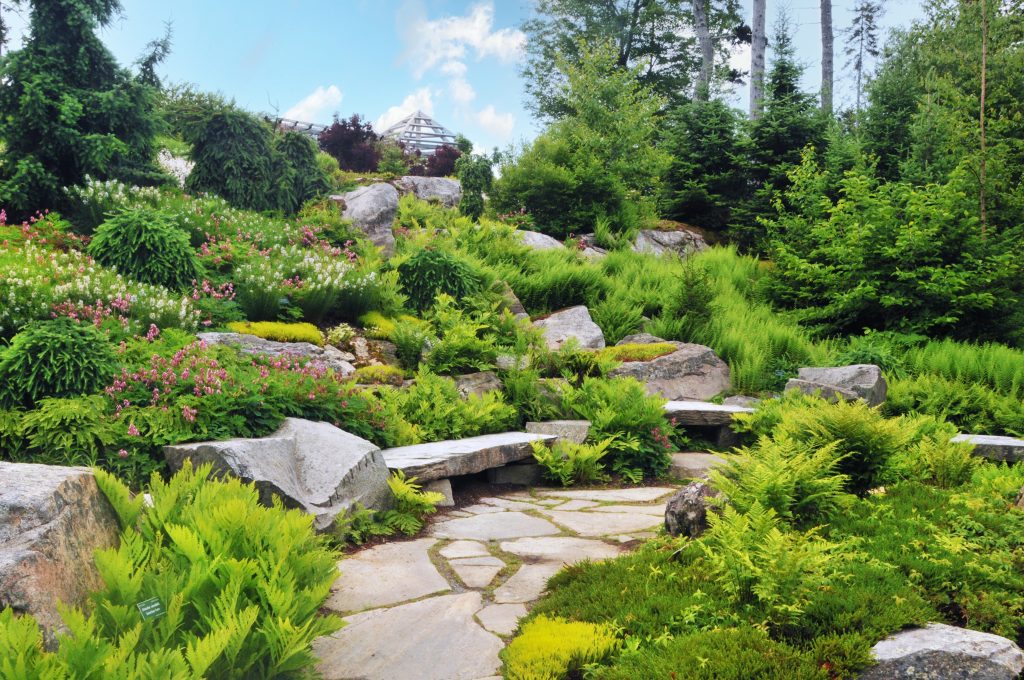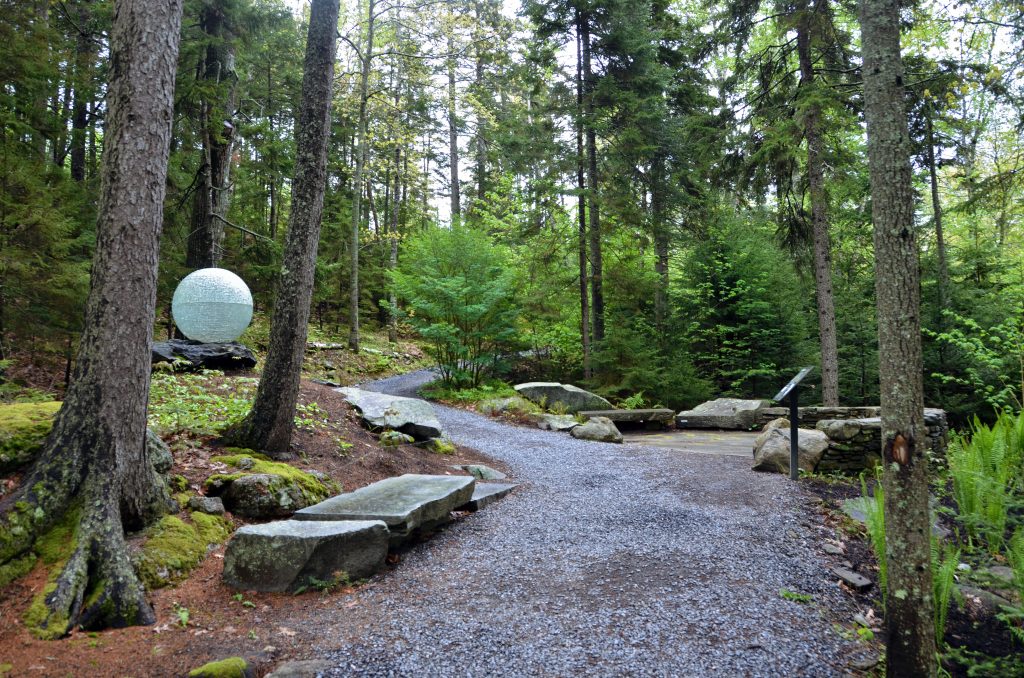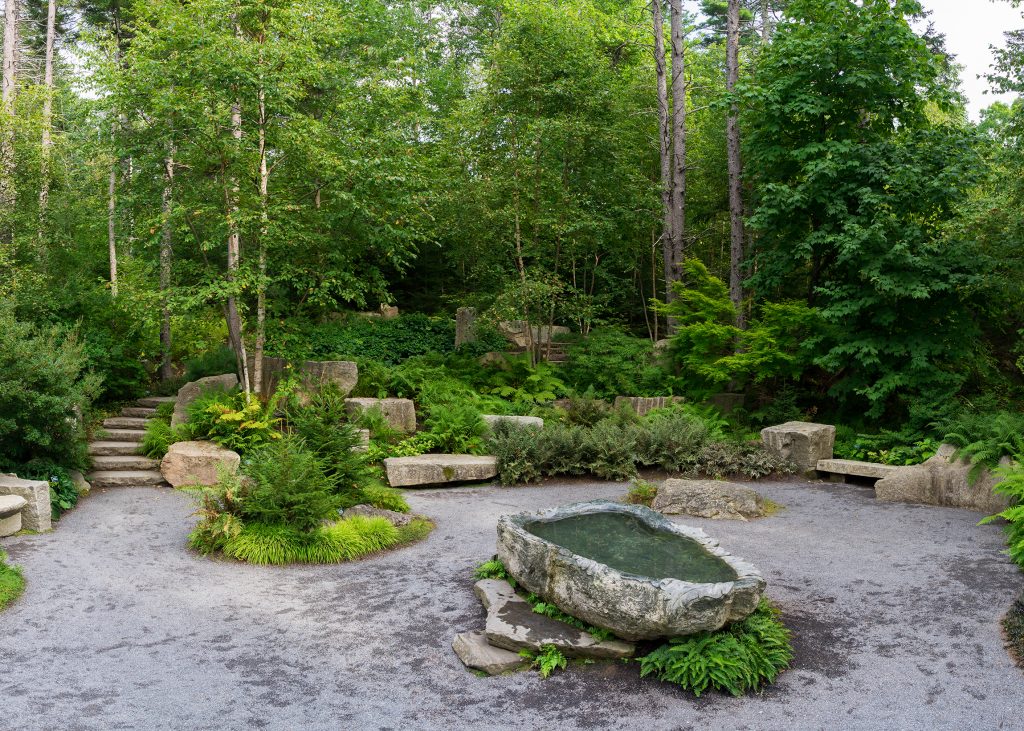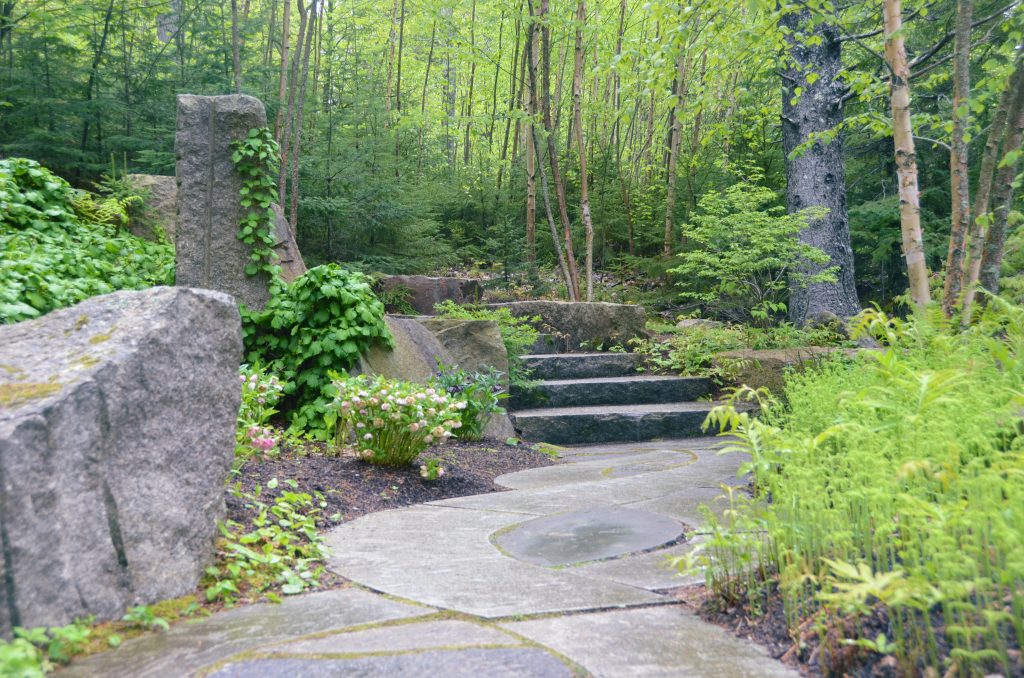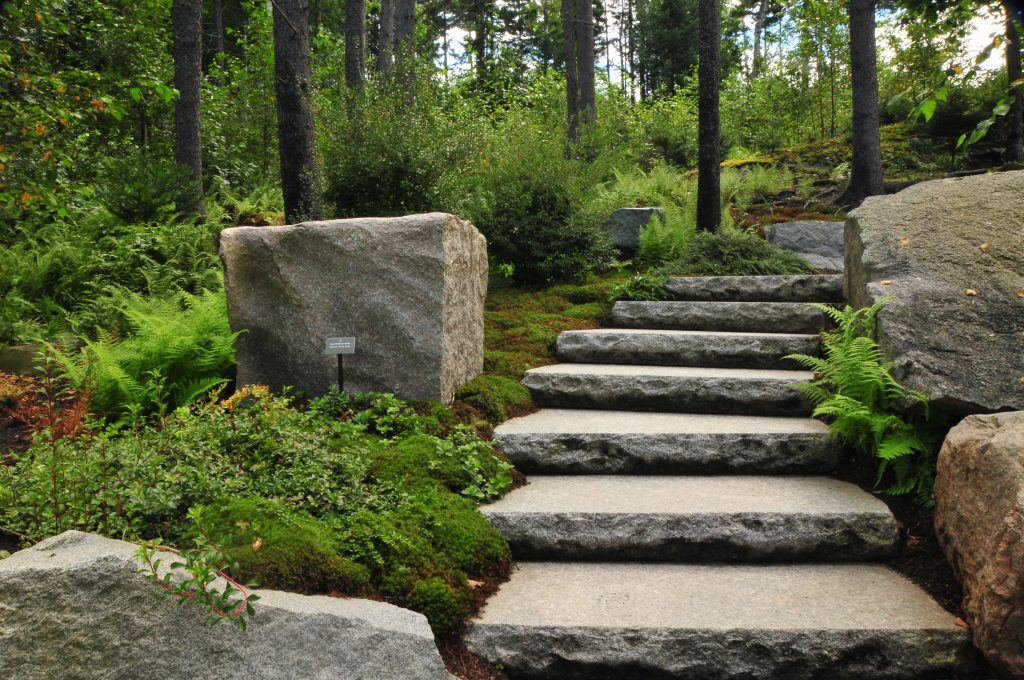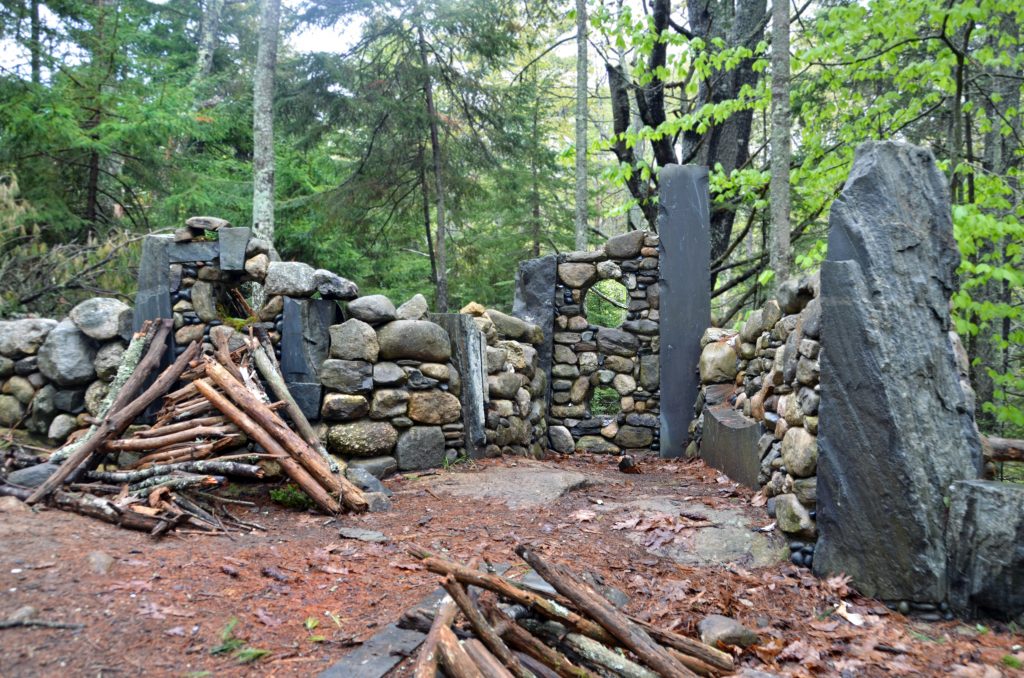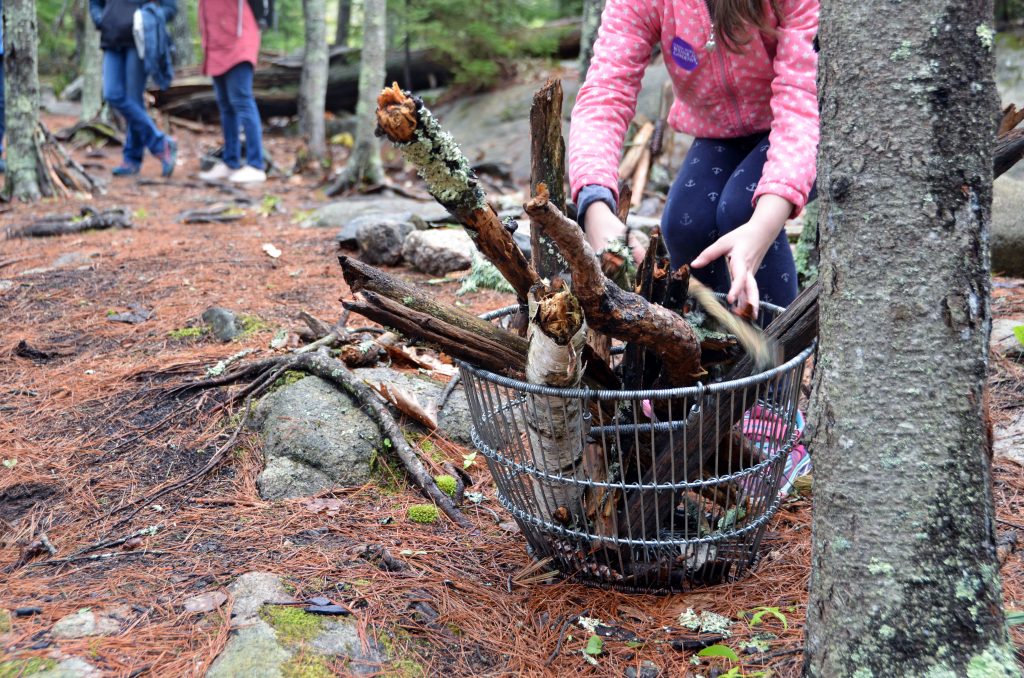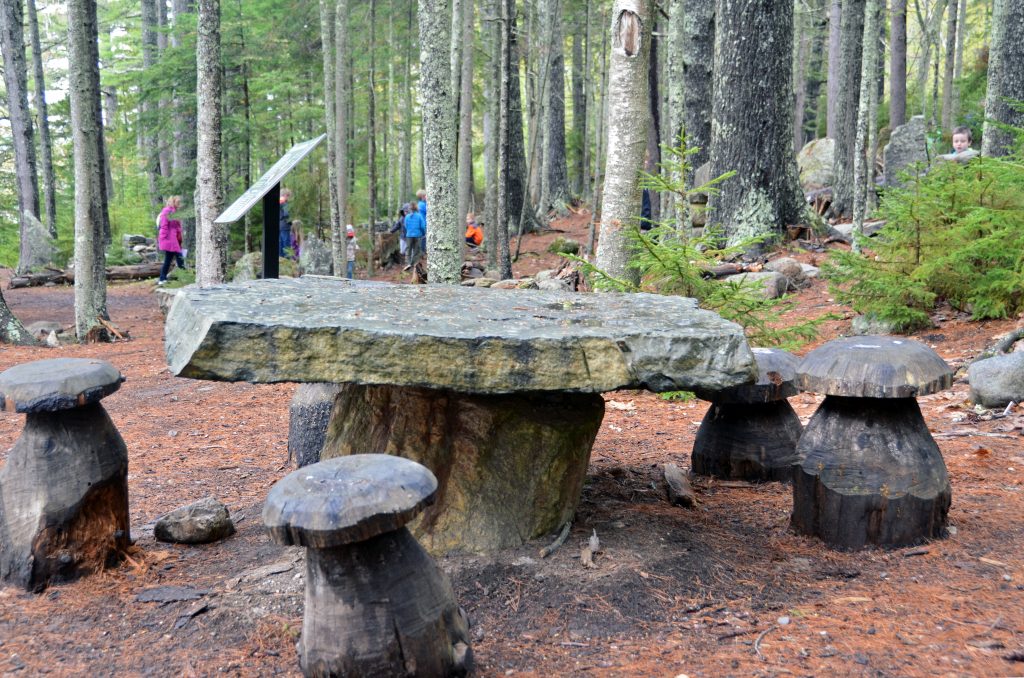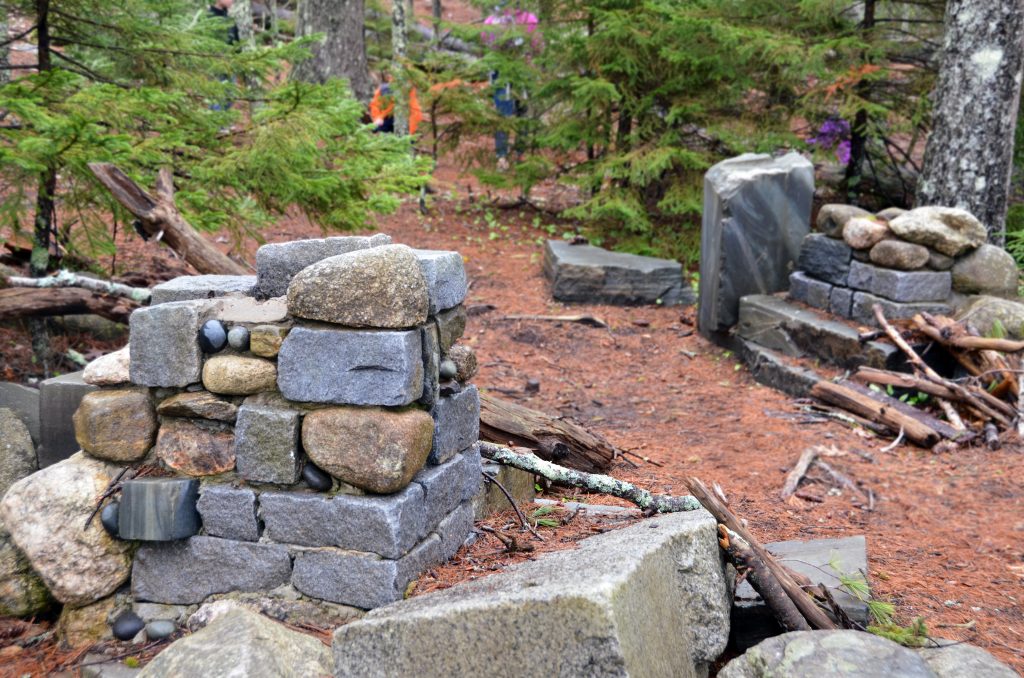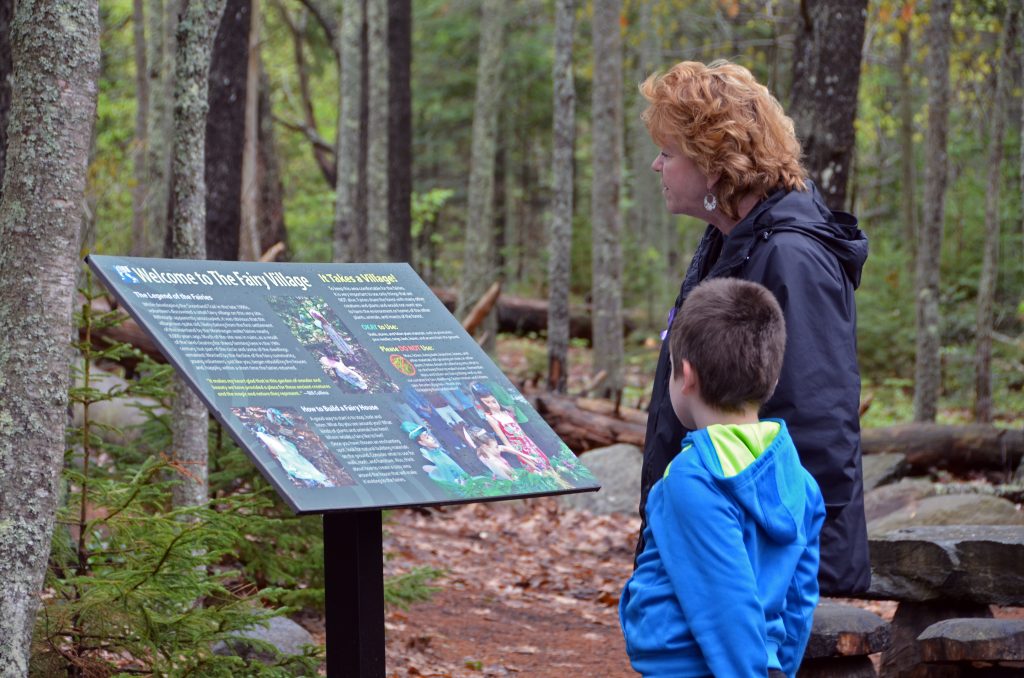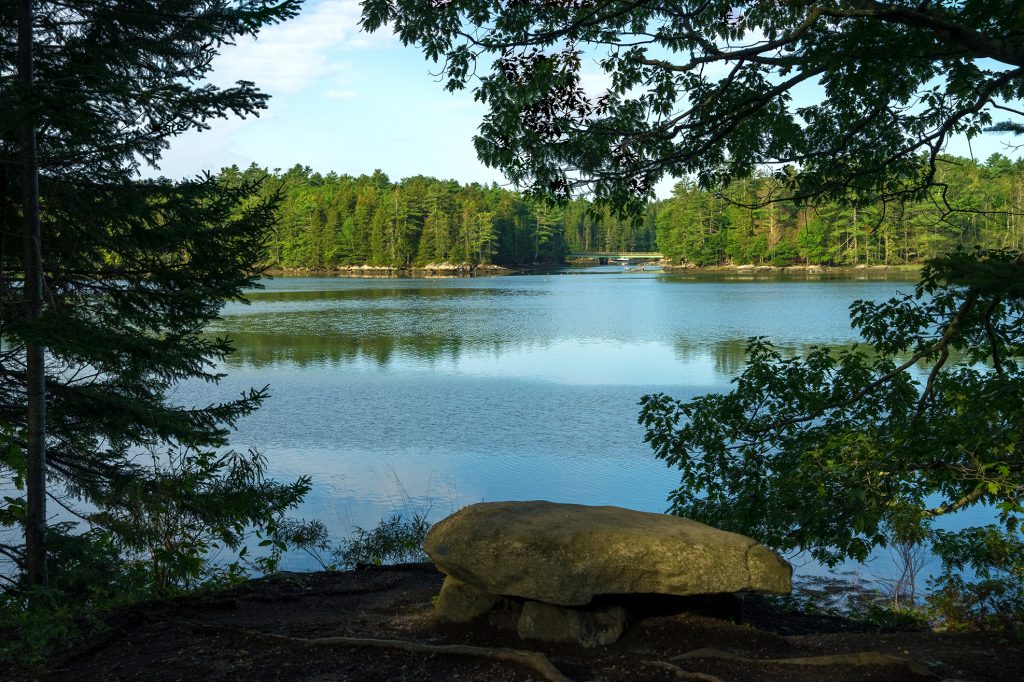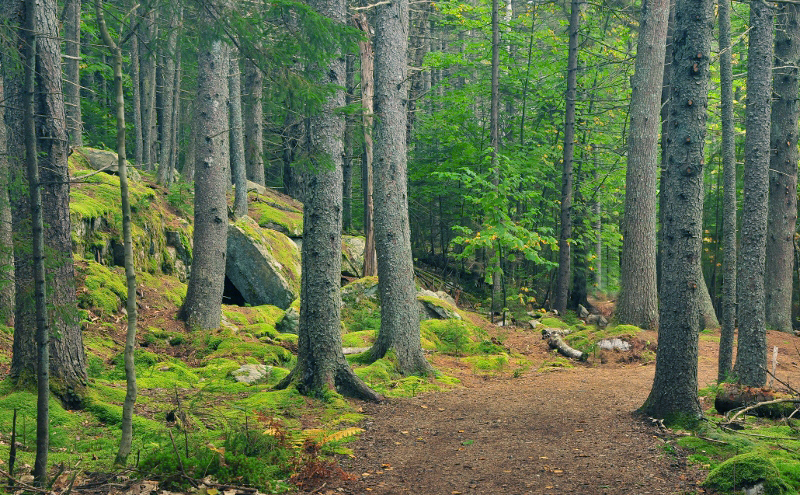Explore our more than 300 acres of gardens and natural spaces, from the Native Butterfly and Moth House to the Bibby and Harold Alfond Children’s Garden or Giles Rhododendron and Perennial Garden.
Gardens & Key Features
Butterfly House | Dahlia Garden | Bee Exhibit | Great Lawn | Giles Rhododendron & Perennial Garden | Lerner Garden of the Five Senses | Slater Forest Pond | Cleaver Lawn | Arbor Garden | Burpee Kitchen Garden | Bibby & Harold Alfond Children’s Garden | Haney Hillside Garden | Vayo Meditation Garden | Fairy House Village | Shoreland Trail & The Landing
Native Butterfly House
The Native Butterfly House opened June 1, 2018. The 2,160 square-foot, Gothic-style hoop house features shade screening and a planting scheme dedicated to supporting the entire life cycle of moths and butterflies native to Maine and New England, from caterpillar to moth or butterfly. The House and its surrounding gardens offer visitors the opportunity to observe every stage of the pollinators’ growth first-hand. At any given time, visitors can find mourning cloaks, American ladies, painted ladies, red admirals, black swallowtails, and monarch butterflies in residence. Moth species include Luna, Polyphemus, and cecropia.
Dahlia and Iris Garden
The Dahlia and Iris Garden, dedicated in appreciation to Board member Mary B. Neal, began as a dahlia trial garden. So popular proved the flowers, however, that it soon became a permanent fixture. The spiral-shaped garden offers a veritable tour of the flower’s possibilities, showcasing five dozen exceptional varieties of varying form and color. Eighty cultivars from all major dahlia groups—from dinner plate-sized blooms to dainty orchid varieties—represent virtually every color of the rainbow (except true blue which, despite a £1,000 reward first offered in England in 1826, is a color yet to be achieved). Dahlias are, in the words of CMBG horticulturist Courtney Locke, “the apotheosis of the flower world, with an almost infinite diversity of form and color.”
Learning Apiary and Native Bee Exhibit
Beehives first came to the Gardens in 2016, and 16 honey bee hives now make their home here. CMBG’s Learning Apiary offers visitors the chance to watch a number of honey bee families (hives) carry out daily operations like gathering food and water, cleaning the hive, communicating about food resources, reproduction, comb building, honey production, honey storage, and temperature regulation. A fence surrounding the apiary raises bees’ flight path above the heads of visitors, assuring the safety of bees and observers alike. As a bonus, one of a handful of resident beekeepers is regularly on hand to answer questions and demonstrate beehive care and upkeep. Our adjacent Native Bee Exhibit introduces visitors to information about Maine’s more than 276 species of bees, fun facts, and tips to help us help them survive and thrive.
Great Lawn
The Great Lawn was inspired by nineteenth-century landscape parks which, in turn, were modeled after pastoral landscapes. The Lawn was designed to create a sense of scale and openness to contrast the densely wooded forest surrounding the Gardens. One of its most distinctive features is Whale Rock, a massive formation of Bucksport schist that rises out of the grass at the southern edge of the lawn. The plantings surrounding the lawn feature broad sweeps of perennials and grasses suggesting a stylized meadow complimenting the adjoining turf. This area also features Founders Grove, a planting of seven narrow pin oaks, blueberries, and grasses commissioned to honor the founders of the Gardens. The Lawn, organically maintained, is for visitors to walk, play, and picnic on.
Giles Rhododendron and Perennial Garden
CMBG’s first planned garden, the affectionately nicknamed “Rhody” Garden sits a third of a mile from the central gardens. This hillside garden features more than a thousand rhododendrons and related shrubs as well as a spring bulb display. The late Ernie Egan, one of the Gardens’ founders and a former president of the American Rhododendron Society, helped select the original 100 plants that became the nucleus for the collection. One of the first to come into bloom in early spring, the Rhody Garden features a pond and waterfall designed by landscape architect Bruce John Riddell as a tribute to long-time Board members and fundraising leaders, John and Sarah Giles. Hostas, ferns, epimediums, and other shade plants provide textural interest throughout the summer months in addition to the more than 175 varieties of rhododendron and azaleas.
Lerner Garden of the Five Senses
After much planning and a generous gift from Daniel and Lyn Lerner, the Lerner Garden opened in June, 2009. Less than an acre in size, winding paths circle through five regions emphasizing the five senses. The olfactory node is planted with fragrant herbs and flowers; the taste node features edible fruits, vegetables, and flowers. At the garden’s high point, the sight node offers a panoramic view of the garden. The path descends to a reflexology labyrinth marking the beginning of the tactile node. The final node, sound, features a large area in which to sit, pause, and listen to the surrounding birds, running water, and resident frogs. The garden also features several designs geared toward universal accessibility. The brick paving’s changes in the surface and pattern help guide visually impaired visitors while providing a smooth, hard surface and gentle slope for wheeled mobility aids. The fountain provides a constant sound to help orient those who cannot see, while ample opportunities for tactile and visual stimulation provide interest for those who cannot hear. Raised beds in the horticultural therapy area feature cutaways to make room for gardeners in wheelchairs.
Slater Forest Pond
This garden was built in a naturally low-lying area well-suited to a small pond. The pond, excavated, lined, and replanted with native shrubs, trees, and water-loving plants in 2006, is filled with frogs and aquatic insects. Large stepping stones set into the water are an instant favorite with children of all ages. The pond’s minnows, dragonfly nymphs, and other local wildlife keep mosquito populations at bay, even in high summer. Beautiful water lilies feature sweetly scented flowers that appear continuously throughout the summer; as all are forms of our native species, they’re happily winter-hardy.
Cleaver Lawn
This area was designed, in part, to help build a research collection of certain plants. The first CMBG established was its collection of kousa dogwood (Benthamidia japonica). With a gift from the Cleaver family of Southport Island, Maine, construction on the lawn, originally designed as an event space, began in 2008. In keeping with its celebratory theme, the planting design relies heavily on white, pastel pink, yellow, and blue-flowered species. One of its focal points is the grove of dawn redwood (Metasequoia glyptostroboides ‘Ogon’). Adjacent is a smaller oval of turf featuring a fieldstone terrace bordering moss-covered outcrops. The woodland area to its north showcases a dozen species of native mosses and companion plants.
Arbor Garden
Designers at the Gardens wanted to draw inspiration from the formal rose garden tradition of European botanical gardens, but with an informal twist. The focal point of this garden is a large post-and-beam arbor made from Douglas fir. Climbing roses, native wisteria, clematis, ornamental grapes, and honeysuckle drape the structure in foliage and flowers. Vigorous, disease-resistant shrub roses suited to our cool, coastal climate surround the arbor. To add variety, perennials, vines, and long-blooming annuals are interspersed among the roses.
Burpee Kitchen Garden
The concept of a kitchen garden is most likely as old as agriculture itself. Thanks to a gift from the Burpee Foundation, the corporate giving foundation of the W. Atlee Burpee Seed Company, this garden began in 2006. Designed to meet the demands of the Kitchen Garden Café, it provides our chefs with signature herbs, edible flowers, fruits, and vegetables, all within easy walking—and harvesting—distance. Every year, fresh compost is dug in and vegetables, herbs, and edible flowers are set out in esoteric patterns. Favorites include Swiss chard, red leaf lettuce, nasturtiums, lemon gem marigolds, tricolor sage, basil, dwarf cabbages, creeping rosemary, and golden-leaved thyme. In 2012, the garden was expanded to include café tables, inviting diners not only to taste the fruits of this garden, but to enjoy their food in it as well.
Bibby and Harold Alfond Children’s Garden
Thanks to a generous challenge gift from the Harold Alfond Foundation, this garden opened on July 8, 2010. It encompasses two acres of woods, ponds, and theme gardens inspired by well-known children’s books by Maine authors, including Down to the Sea with Mr. Magee (Chris Van Dusen), Burt Dow, Deep-Water Man and Blueberries for Sal (Robert McCloskey), Charlotte’s Web (E.B. White), and The Stone Wall Dragon (Rochelle Draper), among others. Designed by landscape architect Herb Schaal, the garden is divided into a series of separate spaces, each with its own identity and focus. Attractions include a learning garden, greenhouse, chicken coop, a terrace planted with a rainbow of flowers, story barn, play cottage, small pond, treehouse, and maze lawn inspired by an English design. In the summer, this garden is rife with daily activities from chicken feeding to storytime, puppet shows to July and August’s fairy festivities.
Haney Hillside Garden
With a generous gift from board members and retired executives from the fields of journalism and finance, Dan and Susan Haney, construction on this garden began in 2005. The challenging steep, rocky hillside garden features three terraces linking 1,000 feet of switchback paths. A water terrace is followed by a moss terrace; a final terrace features a glass orb by New York sculptor Henry Richardson. Though it opened in 2006, the Patriot’s Day Storm of 2007 wreaked havoc on the exposed hillside, and the garden was completely renovated in 2010-11. Six thousand native plants are installed in the upper areas while the lower areas near the shoreline rely primarily on careful editing of the natural vegetation.
Vayo Meditation Garden
This meditative garden was designed as a quite retreat for those seeking the tranquility of the shore. Built with the calming effect of boundaries between land and water in mind, construction began in 2005 after a gift from the Vayo family of Sawyer Island, Maine. All of the stone used had to be hauled down the hillside piece by piece—a task made even more challenging by record rainfall that year. To complete the garden, a large central basin carved by Plymouth, Maine, sculptor David Holmes was placed to unify stone, water, and sky. Carved from a soapstone-like rock called Ellsworth schist, the boulder used was found in a blueberry field near Mount Desert Island, Maine.
Fairy House Village
The Fairy House Village, nestled in a hilly forest clearing overlooking the shoreline, offers enterprising children of all ages the natural materials needed to construct whimsical, if ephemeral, fairy dwellings. A tradition said to have originated in the woods on nearby Monhegan Island, structures can only be built from non-living materials found on the forest floor. Luckily, there’s no shortage of building supplies. A regular visit to the Village would present a different world altogether from day to day. Birch bark, stones, sticks, and leaf litter grace the ground—treasure and building supplies hidden in plain sight.
Shoreland Trail & The Landing
The first task early volunteers undertook was to develop a trail system through the Gardens’ woods and along the waterfront. Christened the Shoreland Trail, this roughly three-mile network of footpaths takes visitors through some stellar examples of Maine’s forests and ledges. Celebrating indigenous trees, shrubs, wildflowers, ferns, and mosses, the trail ends at the Landing, a dock serving as a beautiful overlook of the Back River, a working waterfront. This is a chance for visitors to pause and take in a quiet moment, some sea breezes, and a bit of wildlife-spotting.
